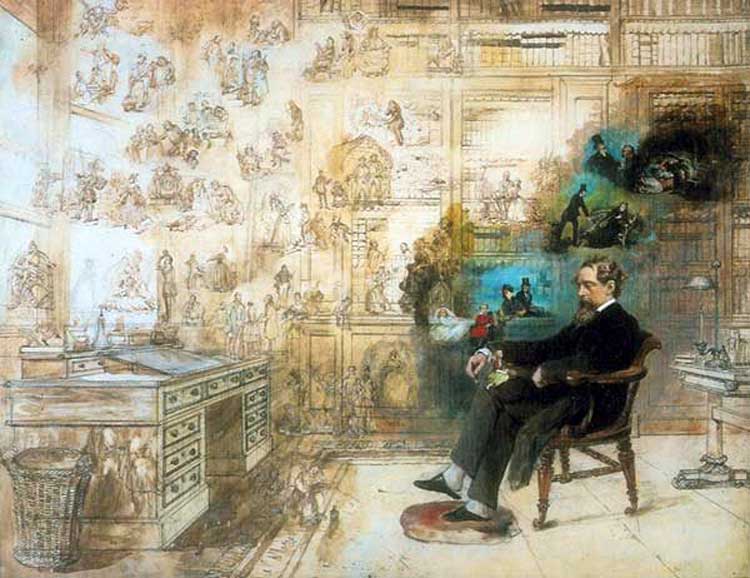
| Start: Chancery Lane Underground Station. | Duration: 2 Hours 45 minutes |
| Best of Times: Weekdays 10am to 4pm. | Worst of Times: Evenings and Weekends |
This is, without doubt, one of my favourite Dickensian routes in London. It is crammed with places that Dickens knew intimately and about which he wrote frequently.
It offers a delightful stroll through Dickens London, and it takes you from the peaceful quietude of Staple Inn, through the timeless solitude of Lincoln's Inn, and on to the tranquil oasis that is the Temple.
Having explored this lovely London enclave, you will then venture along Fleet Street to dip in and out of the numerous alleyways that snake off it, and which offer a myriad of surprises to the intrepid wanderer.
The final section of the tour will bring you along the north side Holborn to find more Dickensian surprises, including the site of the place at which he was residing when fame, quite literally, came knocking on his door.
Your explorations will end at the Charles Dickens Museum, on Doughty Street, where you can explore the interior of the only one of his London houses to have survived,
And, as you make your way through the streets of London, you will be able to see the locations you visit through Dickens' eyes and read his evocative descriptions of the very places you will be looking at.
In short, this walk has it all.
Here are some of the highlights that you will encounter as you make your way through the historic streets of London:-
And, betwixt and between these fascinating locations, you will uncover buildings, pubs, streets and houses that have hardly changed, if they have changed at all, since Dickens came to visit them in search of inspiration for some of the most memorable passages in English literature.
Leave Chancery Lane Underground Station via exit three, which will bring you out onto Holborn. Almost immediately on the right is the black and white timbered façade of Staple Inn.
Staple Inn with its lattice windows set back in all sorts of angled gables, must surely rate as one of the most exquisite relics of old London.
It dates from 1576, although it had to be pieced back together following considerable bomb damage in World War Two.
It is so named because it once provided London accommodation for wool-staplers or brokers.
"Behind the most ancient part of Holborn," wrote Dickens in his last and unfinished novel The Mystery of Edwin Drood (1870), "...where certain gabled houses some centuries of age still stand looking on the public way...is a little nook...called Staple Inn. It is one of those nooks, the turning into which, out of the clashing street, imparts to the relieved pedestrian the sensation of having put cotton in his ears and velvet soles on his boots."
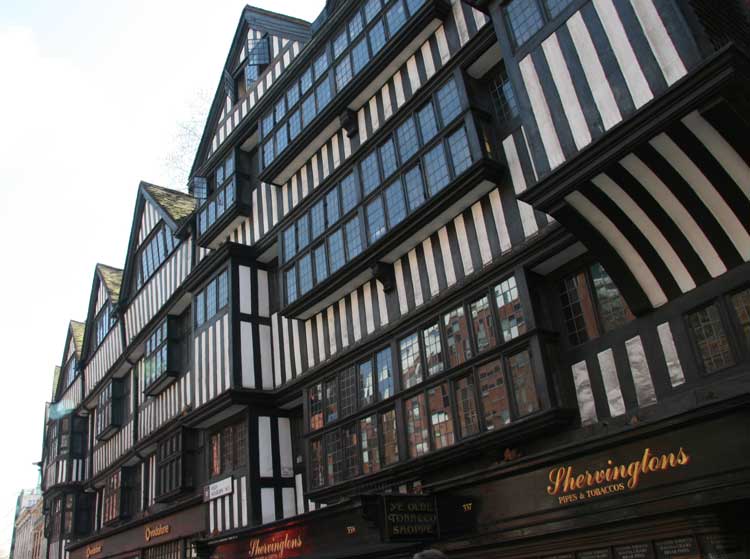
The Facade Of Staple Inn.
To experience how little this secret niche has changed since Dickens wrote those words, go right through the ancient gateway and enter Staple Inn itself.
Continue into the first courtyard and stop to absorb the wonderful ambience of this truly enchanting place.
Suddenly the rush and noise of modern London all but disappears. Huge Plane trees tower over you, and 18th or 19th century redbrick buildings surround you.
"It is one of those nooks," observed Dickens, "where a few smoky sparrows twitter in smoky trees, as though they called to one another, "let's play at country." Moreover it is one of those nooks which are legal nooks: and it contains a little Hall, with a little lantern in its roof..."
Despite the changes that have taken place in the area since Dickens's day his description still holds true today, and as you stand in this little slice of bygone London, you get the genuine sensation that you have literally stepped back in time!
Today the buildings are used as offices by numerous actuaries, so it is a comforting thought that the people you catch glimpses of beavering away behind the ancient facades are working out such intriguing statistics as your chances of ending the walk without getting hit by a bus!
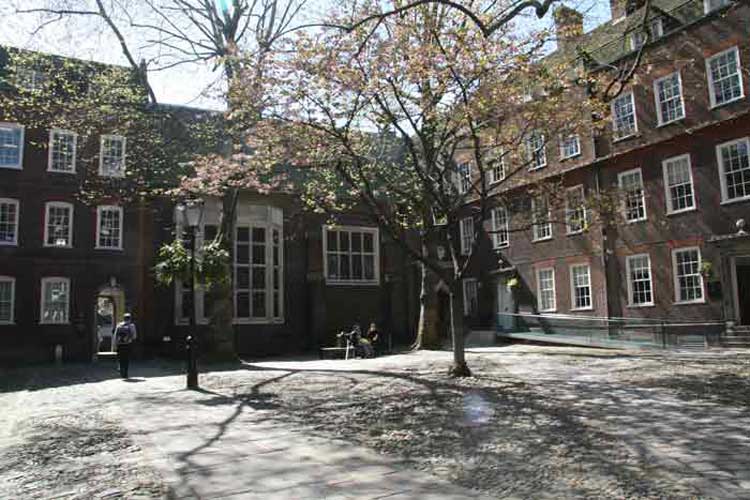
The Inner Court Of Staple Inn.
Keep ahead, passing through the arched passageway, and, at its other side, pause outside the building immediately on the left.
In The Mystery of Edwin Drood, this was the residence of the kindly lawyer Mr Hiram Grewgious, the guardian of Rosa Budd, Edwin Drood's fiancée.
Notice the stone above the doorway which is inscribed 'PJT 1747.'
Dickens comments on this stone that Mr Grewgious had never "troubled his head" as to its meaning, "...unless to bethink...that haply it might mean Perhaps John Thomas, or Perhaps Joe Tyler."
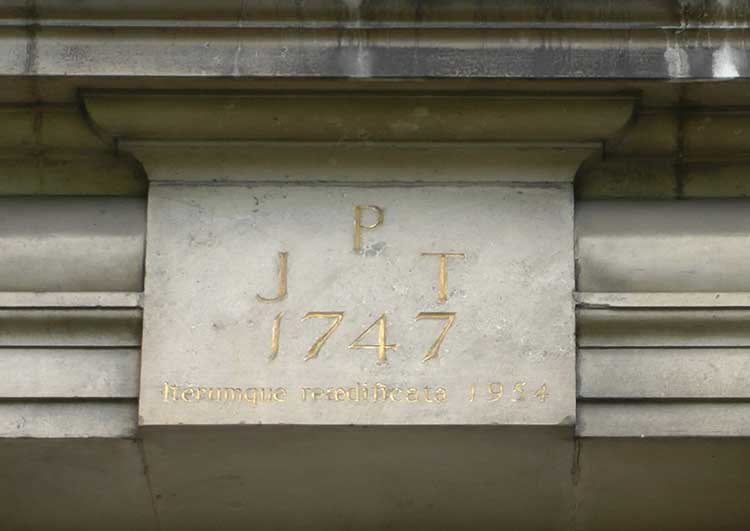
The Stone Above The Door Of Mr Grewgious's Chambers.
Follow the railing as it skirts the pretty little garden; go up the steps and bear right along the pedestrian walkway called Staple Inn Buildings.
Turn right onto Holborn, continue over Furnival Street, and a little way further along, turn right through the iron gates into Barnard's Inn.
Follow the passageways that lead you to a wonderfully evocative inner sanctum.
It was here that Pip and Herbert Pocket had chambers in Great Expectations.
The fact that so many enclaves in this area are referred to as 'inns' when they are, in fact, places of business can be somewhat confusing.
Evidently Dickens also found this a little perplexing, for he has Pip ruminate upon the fact when he first visits Barnard's Inn:-
"I had supposed that establishment to be an hotel kept by Mr Barnard...whereas I now found Barnard to be a disembodied spirit, or a fiction, and his inn the dingiest collection of shabby buildings ever squeezed together, in a rank corner, as a club for Tom-cats."
Either Dickens was being a little harsh in his criticisms , or the area has changed considerably since his day, for today this really is a truly lovely spot and its well worth lingering a little to enjoy its secluded ambience.
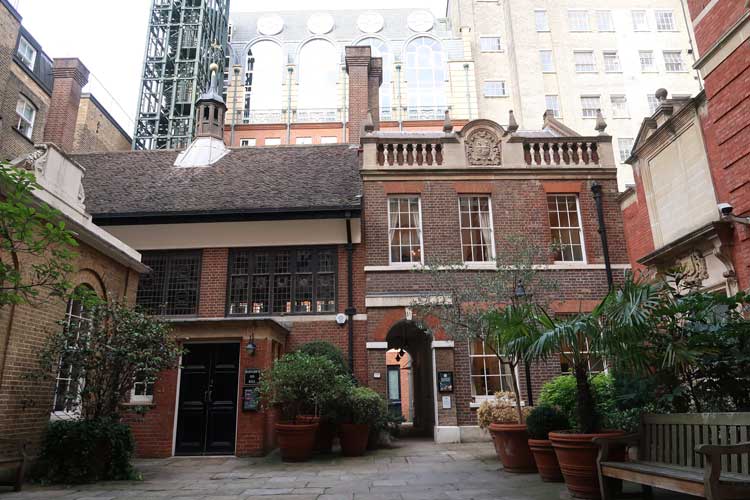
Barnard's Inn.
Once you have absorbed to your hearts content backtrack out of Barnard's Inn and back to Furnival Street.
Turn right into Took's Court, which Dickens re-named Cook's Court in Bleak House (1852-53).
Situated on the left, just after the road veers sharp left, pause outside number 15, a very pleasing early 18th century building.
This has been re-named 'Dickens House' and it was here that the meditative law stationer Mr Snagsby lived and worked in Bleak House.
Mr Snagsby "dealt in all sorts of blank forms of legal process, in skins and rolls of parchment, in paper - foolscap, brief, draft, brown, white, whitey-brown, and blotting; in stamps, office quills, pens, ink, India rubber, pounce, pins, pencils, sealing wax and wafers; in red tape and green ferret; in pocket books, almanacks, diaries and Law lists; in string, boxes, rulers, inkstands (glass and leaden), penknives, scissors, bodkins, and other office cutlery.' He was "the high standard of comparison among neighbouring wives, a long way down Chancery Lane on both sides.'
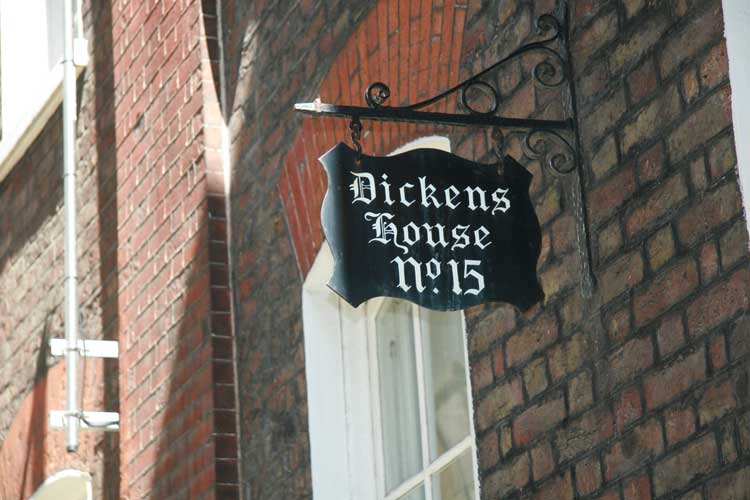
The Dickens House - Home Of Mr Snagsby.
Continue ahead, turn right along Cursitor Street, right onto Chancery Lane and cross to the Gatehouse of Lincoln's Inn, which had to be rebuilt in the 1950's as it was in danger of imminent collapse!
On his first day of working for Ellis and Blackmore, the then teenage Dickens, in a blue jacket and "military-looking cap which had a strap under the chin" met a "big blackguard fellow" in front of these gates.
The 'blackguard' knocked off his cap and said, "Halloa, sojar," which, as Dickens later recounted, when he returned to the office sporting a black eye, "I could not stand, so I at once struck him and he hit me in the eye."
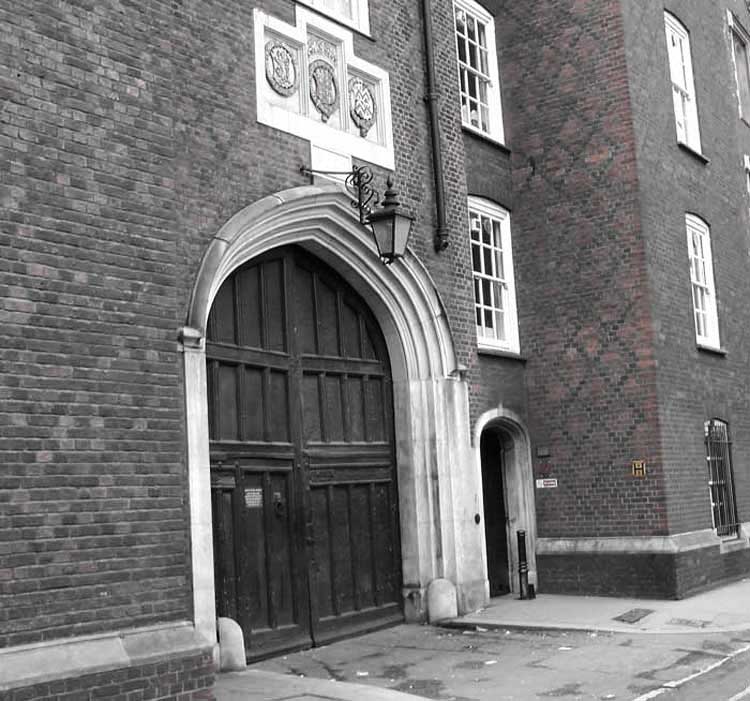
The Old Gate Outside Which Dickens Had His Memorable Encounter.
Go through the gates, which date from the 16th century, and enter Lincoln's Inn one of London's four Inns of Court.
Lincoln's Inn is only accessible to the public Monday to Friday until 6.30pm, so you will not be able to include this section of the tour at weekends or after 6.30pm at night, since the gate will be closed and locked.
If this is the case, turn left as you face the gate, walk along Chancery Lane, and turn right along Carey Street, just by the Knight's Templar pub. Keep walking along it, and go right along Serle Street, which leads to Lincoln's Inn Fields, where you can pick up the next section of the walk.
Immediately the surroundings change to a delightful combination of dark brick and light stone buildings.
The redbrick building on the other side of the lawn is the Old Hall, dating back to 1489, and which - before the construction of the Law Courts on the Strand, was where the Lord Chancellor's Court met outside of legal terms.
It was here in "Implacable November weather" that Bleak House began with its vivid images of a London fog:-
"London. Michaelmas term lately over, and the Lord Chancellor sitting in Lincoln's Inn Hall. Implacable November weather. As much mud in the streets as if the waters had but newly retired from the face of the earth, and it would not be wonderful to meet a Megalosaurus, forty feet long or so, waddling like an elephantine lizard up Holborn Hill. Smoke lowering down from chimney-pots, making a soft black drizzle, with flakes of soot in it as big as full-grown snowflakes - gone into mourning, one might imagine, for the death of the sun. Dogs, undistinguishable in mire. Horses, scarcely better; splashed to their very blinkers. Foot passengers, jostling one another's umbrellas in a general infection of ill temper, and losing their foot-hold at street-corners, where tens of thousands of other foot passengers have been slipping and sliding since the day broke (if this day ever broke), adding new deposits to the crust upon crust of mud, sticking at those points tenaciously to the pavement, and accumulating at compound interest.
Fog everywhere. Fog up the river, where it flows among green aits and meadows; fog down the river, where it rolls defiled among the tiers of shipping and the waterside pollutions of a great (and dirty) city. Fog on the Essex marshes, fog on the Kentish heights. Fog creeping into the cabooses of collier-brigs; fog lying out on the yards and hovering in the rigging of great ships; fog drooping on the gunwales of barges and small boats. Fog in the eyes and throats of ancient Greenwich pensioners, wheezing by the firesides of their wards; fog in the stem and bowl of the afternoon pipe of the wrathful skipper, down in his close cabin; fog cruelly pinching the toes and fingers of his shivering little 'prentice boy on deck. Chance people on the bridges peeping over the parapets into a nether sky of fog, with fog all round them, as if they were up in a balloon and hanging in the misty clouds.
Gas looming through the fog in divers places in the streets, much as the sun may, from the spongey fields, be seen to loom by husbandman and ploughboy. Most of the shops lighted two hours before their time - as the gas seems to know, for it has a haggard and unwilling look.
The raw afternoon is rawest, and the dense fog is densest, and the muddy streets are muddiest near that leaden-headed old obstruction, appropriate ornament for the threshold of a leaden-headed old corporation, Temple Bar. And hard by Temple Bar, in Lincoln's Inn Hall, at the very heart of the fog, sits the Lord High Chancellor in his High Court of Chancery.
Never can there come fog too thick, never can there come mud and mire too deep, to assort with the groping and floundering condition which this High Court of Chancery, most pestilent of hoary sinners, holds this day in the sight of heaven and earth."
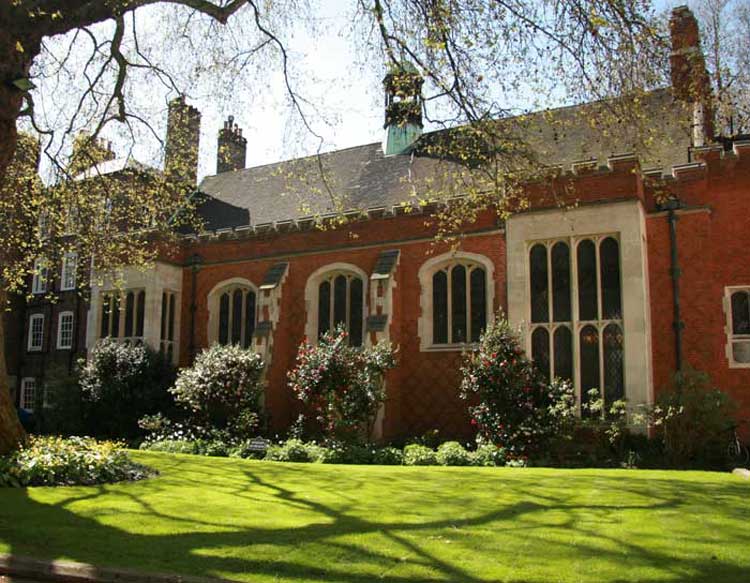
Lincoln's Inn Old Hall.
Turn right as you face the hall and lawn, and make your way into:-
The atmospheric cloisters date from 1623 and they make for a wonderful respite from the hustle and bustle of modern London. Indeed, such is the ambience of this lovely oasis, you could almost believe that you had somehow slipped back in time.
In Chapter Three of Bleak House, Esther Summerson arrives in Lincoln's Inn during a dense London fog and makes her way to Old Square, which is the square across which you have just walked.
She describes her journey here thus:-
"We drove slowly through the dirtiest and darkest streets that ever were seen in the world (I thought) and in such a distracting state of confusion that I wondered how the people kept their senses, until we passed into sudden quietude under an old gateway and drove on through a silent square until we came to an odd nook in a corner, where there was an entrance up a steep, broad flight of stairs, like an entrance to a church. And there really was a churchyard outside under some cloisters, for I saw the gravestones from the staircase window..."
The graves to which Dickens alludes can be seen dotted across the flagstone floor of the cloisters.
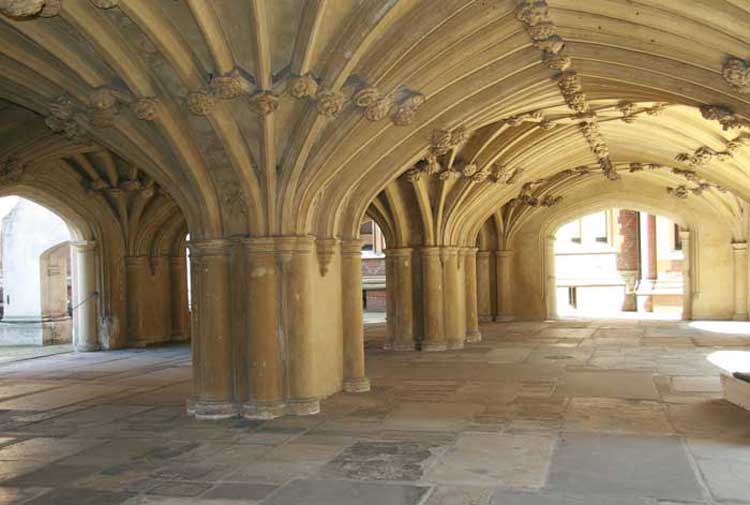
The Cloisters Of Lincoln's Inn.
Turn left to walk through the cloisters towards the steps at their west end. The stairs on either side lead up to the chapel, which, if open, is well worth a visit.
The chapel's foundation stone was laid in 1620 by the metaphysical poet and divine John Donne (1571/2 - 1631).
He was actually the Inn's preacher between 1616 and 1622, and was persuaded to return to preach the first sermon in the chapel in 1623. So crowded was the chapel that 'two or three [of the congregation] were endangered and taken up for dead for the time, with the extreme press and thronging.'
The chapel interior possesses some fine Jacobean pews and some striking stained glass.
Whenever a bencher (a member of the Inn's governing body) dies, the chapel bell is rung to mark their passing. It was the mourning knell tolled by this bell that is reputed to have inspired John Donne to write what is probably his most famous prose quotation, "Never send to know for whom the bells tolls; it tolls for thee."
Go down the two steps out of the cloisters (be very cautious at this point as you are, in fact, steeping out onto a road), turn left and, a little way along, pause outside the red-brick Old Hall.
This is where in Bleak House the legal suit of Jarndyce versus Jarndyce droned ever onwards, just as it had been doing for so long that no man alive could remember what it was originally about!
Dickens considered the Court of Chancery detestable and in Bleak House proffers the following warning:-
"This is the Court of Chancery; which has its decaying houses and blighted lands in every shire; which has its warn-out lunatic in every mad-house, and its dead in every churchyard; which has its ruined suitor, with his slipshod heels and threadbare dress, borrowing and begging through the round of every man's acquaintance; which gives to monied might the means abundantly of wearying out the right; which so exhausts finances, patience, courage, hope; so overthrows the brain and breaks the heart; that there is not an honourable man among its practitioners who would not give - who does not often give - the warning, "Suffer any wrong that can be done you, rather than come here!"
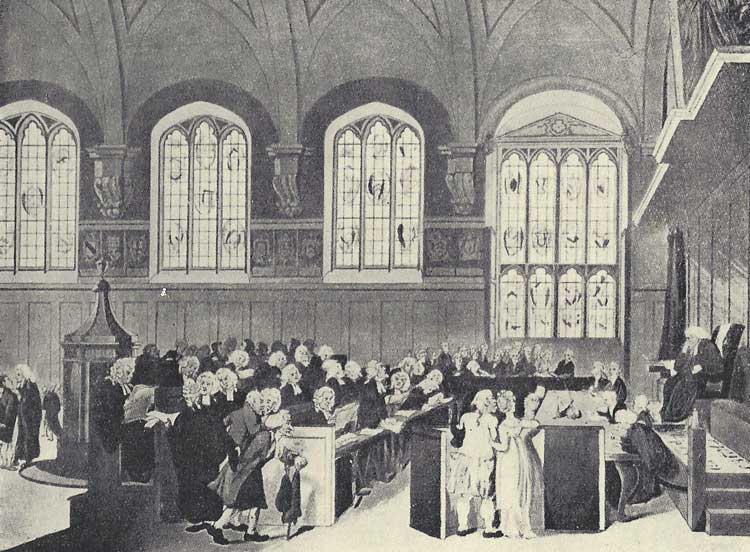
The Court Of Chancery In Session.
Turn your back on the hall and walk towards the large New Hall (built in 1843). However, pause by the garden path on the right, just past the War Memorial, to admire the garden of Lincoln's Inn.
Miss Flite, a possible heir in the Jarndyce vs. Jarndyce suit, and a character whose entire life revolves around the case, observes of this garden:- "I call it my garden. It is quite a bower in the summer time"
The curious little building of red brick and stone, that gives the appearance of being a mini fortress, is in fact the gardeners shed and is known in the inn as "the head gardeners castle."
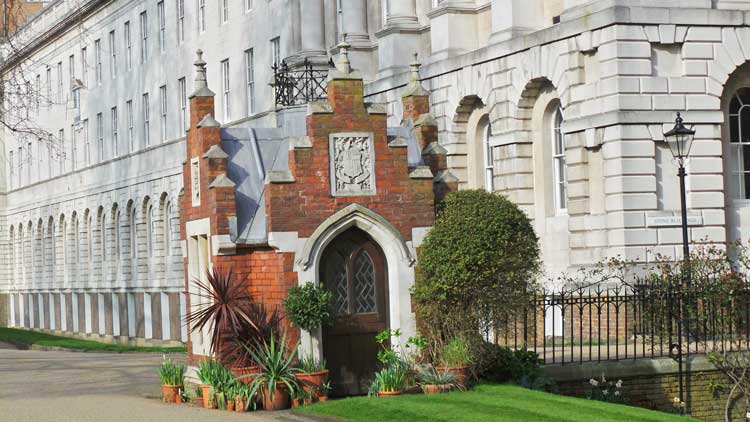
The Gardeners Shed.
Keep ahead, passing to the left of the New Hall.
To your left is New Square, which, given it was built in 1625, is anything but!
The Square has changed so little since Dickens day that in the 1980's it was used as the setting for the TV dramatisation of Bleak House.
Exit through the gates of Lincoln's Inn ahead of you and turn right into into Lincoln's Inn Fields. Keep ahead, which has the distinction of being London's largest Square.
It was here in Barnaby Rudge that the Gordon Rioters gathered.
Proceed counter clockwise around the square turning left, and with the square to your left proceed along its northern fringe until you arrive on the right at:-
13 Lincoln's Inn Fields.
Wednesdays to Sundays, 10am - 5pm. Last entry at 16.30
Admission: Free.
Sir John Soane (1753-1837), architect of the Bank of England and 10 Downing Street, reconstructed this house in 1792, and furnished it with a veritable treasure trove of all things beautiful, instructive and curious.
Before he died, he succeeded in obtaining an Act of Parliament, which ensured that the houses - he expanded next door when his collection outgrew the original premises! - and their contents would be preserved as a public museum.
Of particular interest, from a Dickensian point of view, are the original paintings of William Hogarth' (1697-1764) The Rakes Progress and The Election Campaign. Hogarth was an astute observer and commentator on the social scene of 18th-century London.
He was a favourite artist of the young Dickens, whose early style was greatly influenced by the narrative manner of Hogarth's works.
Later in life, Dickens commented on Hogarth's compassion and praised him for his awareness of "the causes of drunkenness among the poor."
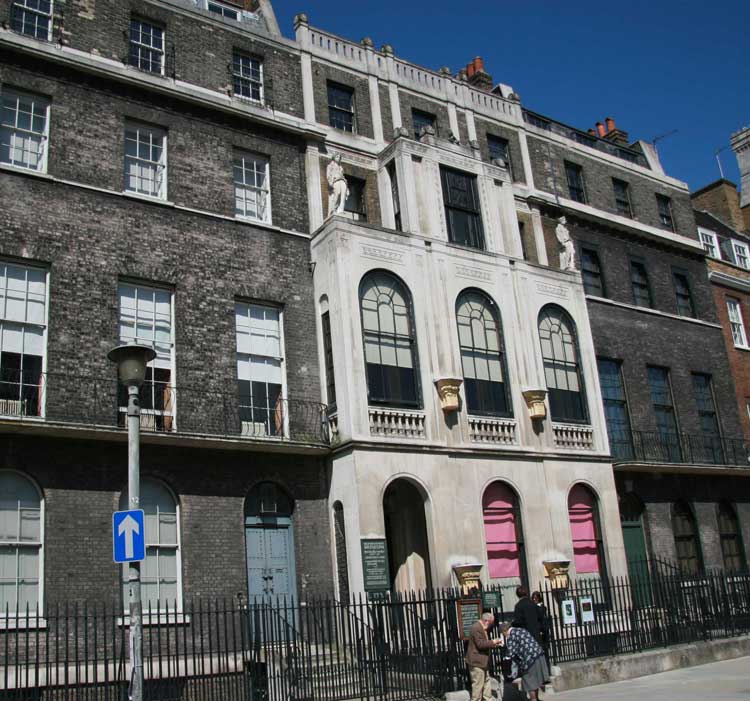
The Sir John Soane Museum.
Keep ahead past the museum (if you choose to visit it turn right out of it), and follow the square when the road turns left.
You will pass number 65 on your right where a blue plaque remembers it as the former home of William Marsden (1796-1867) one of the great figures of 19th-century healthcare and founder of both the Royal Free and the Royal Marsden hospitals.
A few doors further along you will pass numbers 59 and 60, which is:-
This building dates back to 1641 and is known as Lindsey House, after its first owner, Robert Bertie, the first Earl of Lindsey.
Unfortunately, his tenure here was cut short by his becoming Charles 1st's commander-in-chief, in which capacity he was killed at the battle of Edgehill in 1642, the first major skirmish of the English Civil War.
A dark plaque on the wall commemorates Spencer Perceval (1762-1812) the only English Prime Minister to have been assassinated. He was gunned down in the lobby of the House of Commons by a Liverpool grocer named John Bellingham, a failed businessman from Liverpool who blamed Perceval for his financial difficulties.
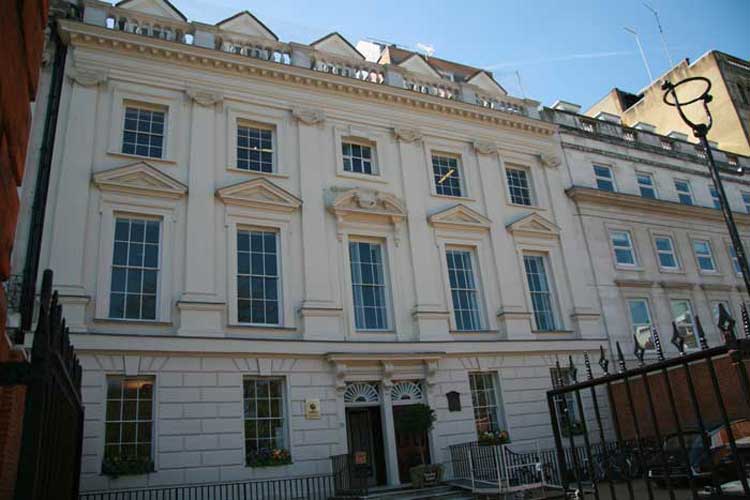
Lindsey House.
The next building along, comprising numbers 57 and 58, Lincoln's Inn Fields, dates from the 18th century, and the grand porch was designed by Sir John Soane.
Dickens friend, business adviser and primary biographer, John Forster (1812 -1865) lived at number 58.
Dickens based the character of Mr Podsnap in Our Mutual Friend (1864-65) on Forster.
Later, he used this house as the residence for Mr Tulkinghorn - legal adviser to Sir Leicester Dedlock and evil blackmailer of his wife, Lady Dedlock - in Bleak House. Dickens was at his lawyer-bashing best when he wrote:-
"The crow flies straight across Chancery Lane...into Lincoln's Inn Fields. Here, in a large house, formerly a house of state, lives Mr Tulkinghorn. It is let off in sets of chambers now, and in these shrunken fragments of its greatness lawyers lie like maggots in nuts."
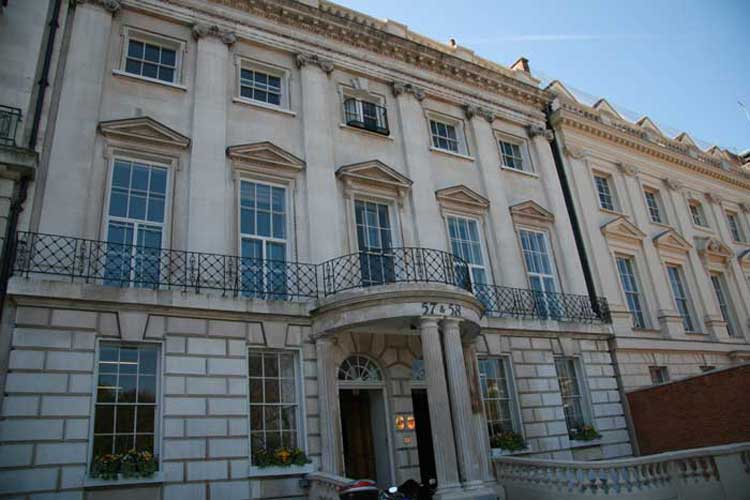
The Former Home Of Dickens Great Friend, John Forster.
On the 2nd December 1844 Dickens, who had travelled especially from Italy - where he was living for a year - gave a private reading at Forster's house from his new Christmas story The Chimes.
The select gathering included, Forster, Thomas Carlyle, and Daniel Maclise.
"There was not a dry eye in the house," Maclise later wrote to Dickens wife, Catherine, who had remained in Italy. "Shrieks of laughter - there were indeed - and floods of tears as a relief to them - I do not think that there ever was such a triumphant hour for Charles..."
Maclise also did a pencil sketch of the occasion, showing Dickens seated at the desk, the book open in front of him. Streaks of light radiate from him and he is surrounded by his enraptured audience.
Forster considered it an accurate depiction of the occasion, although he did comment that there was a touch of caricature of which he considered himself "chief victim."
A second reading two evenings later was equally successful, and thus were sown the seeds of Dickens foray into public readings from his works and, according to Forster, "those readings to larger audiences by which, as much by his books, the world knew him in later life."
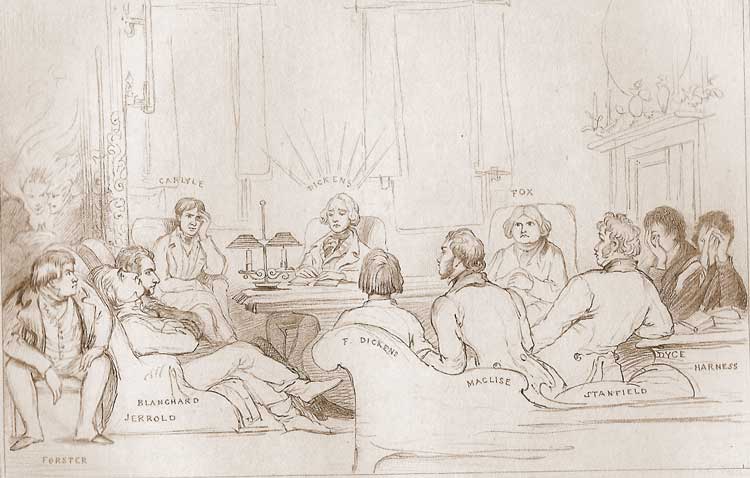
Daniel Maclise's Sketch Of Dickens Reading From The Chimes.
Continue ahead, and keep straight ahead into Portsmouth Street where, a little way along on the left, is:-
This quaint little building long known as "The Old Curiosity Shop" dates from 1567 and was reputedly built from old ship timbers.
The legend, "Immortalized by Charles Dickens", emblazoned on its wall is a bit of wishful thinking.
Dickens emphatically states at the end of The Old Curiosity Shop (1841) that the building of which he wrote was "long ago pulled down."
In a letter to The Echo in 1883, a Mr Charles Tesseyman confessed that his brother, who had dealt in old china, books and paintings from the premises between 1868 and 1877, had added the "Immortalized by" appellation to his shop front for "business purposes."
Following his brother's death, in 1877, the new tenant painted over his name but left the claim displayed on the wall.
Around 1881, an American journalist, who was writing about Dickensian landmarks, arrived at the shop and "straightaway wrote an article in Scribner's Monthly [assuring] his readers that this was the old original Old Curiosity shop of Dickens."
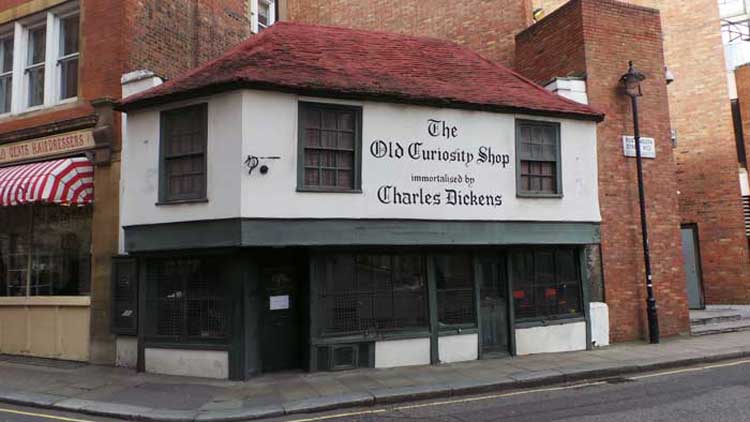
The Old Curiosity Shop.
The George IV pub on the right past the shop, rebuilt since Dickens's day, is thought to have been the original of the Magpie and Stump, where in Pickwick Papers, Jack Bramber tells Mr Pickwick some very bizarre and extremely gruesome stories.
Backtrack to Lincoln's Inn Fields and turn right. Keep ahead until you arrive at the classical, Ionic-columned frontage of:-
Please note that the building is currently undergoing restoration and is encased in scaffolding.
The building was originally built by George Dance and James Lewis between 1806 and 1813. In 1835 it was completely rebuilt by Sir Charles Barry, although he did keep the grand portico with its giant Ionic columns.
Commenting on the lawyers of Lincoln's Inn, Mr Boythorn in Bleak House says that they should have their "necks wrung and their skulls arranged in Surgeon's Hall, for the contemplation of the whole profession, in order that its younger members might understand from actual measurement in early life, how thick skulls may become!"
Today you can do likewise, as all manner of gruesomely fascinating artefacts and anatomical specimens - lawyers skulls excepted - are now on display and open to the public in the college's two museums.
IMPORTANT. Please note that the Museums are currently closed whilst the restoration is being done.
Continue ahead back towards the gate of Lincoln's Inn, which you can see in the distance. Immediately before it, turn right into Serle Street, then left into Carey Street.
The building that dominates its right side is The Royal Courts of Justice, comprising the Civil courts and also the appeal courts, both Civil and Criminal of England. They are open to the public, so you might like to take a break and attend one of the court cases inside.
On the left you will pass The Seven Stars Pub, which dates back to 1602, and which is named for the seven provinces of the Netherlands.
Immediately after the Royal Courts of justice, turn right into Bell Yard, which is the title of Chapter 15 in Bleak House.
Dickens describes Bell Yard as a "narrow alleyway", and that description still holds true today, albeit the fact that its right side is overshadowed by the open space alongside the mighty bulk of the Royal Courts of Justice means that it doesn't give the appearance of being a narrow alley.
It was here in Bleak House that the four orphaned Neckett children lived in an upper room, cared for by the eldest, Charley, who goes out to do washing jobs to support her siblings.
It was also in Bell Yard that Mrs Lovatt had her pie shop at which she sold the finest and tastiest meat pies in London, albeit the main ingredients were supplied by Sweeney Todd, "The Demon Barber of Fleet Street" and consisted of his murdered clients! So tread carefully.
At the far end of Bell Yard, turn right, and pause opposite the monument in the centre of the road. This is:-
This pedestal, surmounted by a bronze dragon, marks the boundary between the Cities of London and Westminster and is the point at which Fleet Street ends and Strand begins.
The statues of Queen Victoria and her son Edward as Prince of Wales are by Sir Edgar Boehm - who is reputed to have died in 1890 whilst in the process of making love to Edward's sister, Princess Louise!
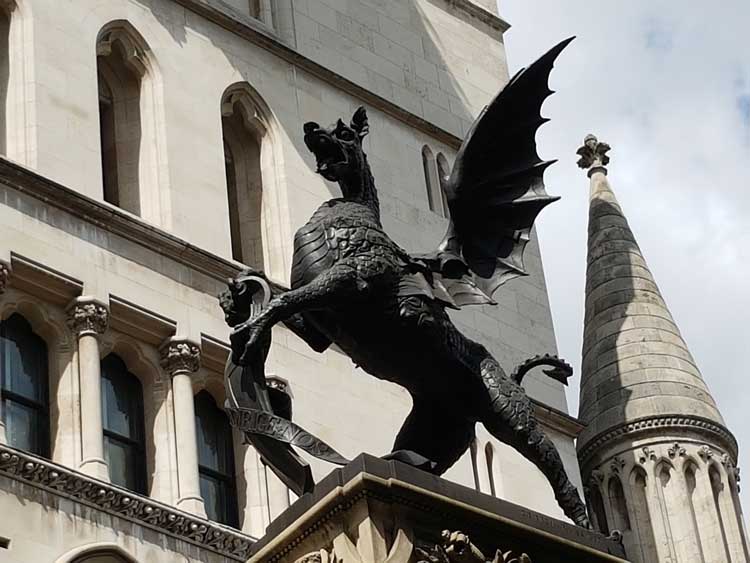
The Dragon Atop Temple Bar.
This, however, is not the Temple Bar that Dickens knew.
In Bleak House Dickens described Temple Bar as:- "that leaden-headed old obstruction, appropriate ornament for the threshold of a leaden-headed old corporation."
In 1888 the leaden-headed old obstruction was transferred to Theobald's Park, in Hertfordshire, and there lay largely forgotten and terribly neglected for over 100 years.
But, in 2004, it was brought back to central London, restored, and re-erected next to St Paul's Cathedral where it can be now be admired by all those who visit St Paul's.
A relief on the column actually shows Temple Bar as it was in Dickens day.
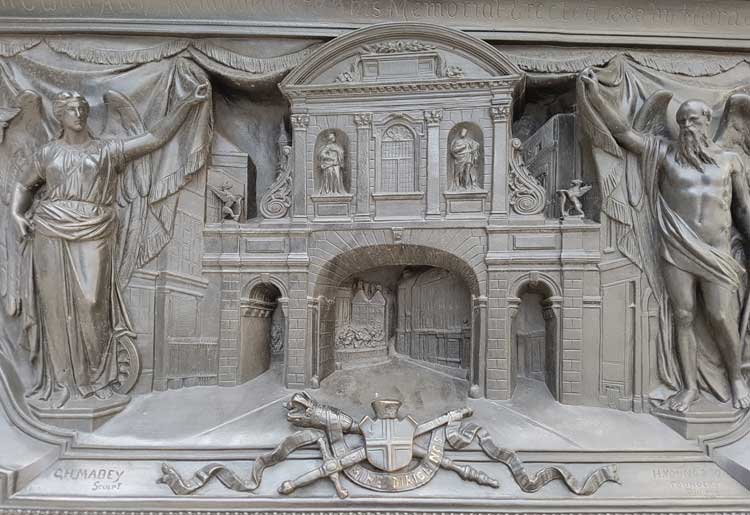
The Relief Showing Temple Bar As Dickens Knew It.
Cross over the road using the island on which Temple Bar stands. This is a very busy road so the utmost caution is called for.
Directly opposite Temple Bar, when you have crossed over, you will find:-
This particular building dates from 1878, when its predecessor was demolished with the removal of Temple Bar.
In A Tale of Two Cities Dickens renamed it "Tellson's Bank" and described it thus:-
"Tellson's Bank by Temple Bar was an old-fashioned place, even in the year one thousand seven hundred and eighty. It was very small, very dark, very ugly, very incommodious. It was an old-fashioned place, moreover, in the moral attribute that the partners in the House were proud of its smallness, proud of its darkness, proud of its ugliness, proud of its incommodiousness. They were even boastful of its eminence in those particulars, and were fired by an express conviction that, if it were less objectionable, it would be less respectable. This was no passive belief, but an active weapon which they flashed at more convenient places of business. Tellson's (they said) wanted no elbow-room, Tellson's wanted no light, Tellson's wanted no embellishment. Noakes and Co.'s might, or Snooks Brothers' might; but Tellson's, thank Heaven!
Any one of these partners would have disinherited his son on the question of rebuilding Tellson's. In this respect the House was much on a par with the Country; which did very often disinherit its sons for suggesting improvements in laws and customs that had long been highly objectionable, but were only the more respectable.
Thus it had come to pass, that Tellson's was the triumphant perfection of inconvenience. After bursting open a door of idiotic obstinacy with a weak rattle in its throat, you fell into Tellson's down two steps, and came to your senses in a miserable little shop, with two little counters, where the oldest of men made your cheque shake as if the wind rustled it, while they examined the signature by the dingiest of windows, which were always under a shower-bath of mud from Fleet-street, and which were made the dingier by their own iron bars proper, and the heavy shadow of Temple Bar. If your business necessitated your seeing "the House," you were put into a species of Condemned Hold at the back, where you meditated on a misspent life, until the House came with its hands in its pockets, and you could hardly blink at it in the dismal twilight. Your money came out of, or went into, wormy old wooden drawers, particles of which flew up your nose and down your throat when they were opened and shut. Your bank-notes had a musty odour, as if they were fast decomposing into rags again. Your plate was stowed away among the neighbouring cesspools, and evil communications corrupted its good polish in a day or two. Your deeds got into extemporised strong-rooms made of kitchens and sculleries, and fretted all the fat out of their parchments into the banking-house air. Your lighter boxes of family papers went up-stairs into a Barmecide room, that always had a great dining-table in it and never had a dinner, and where, even in the year one thousand seven hundred and eighty, the first letters written to you by your old love, or by your little children, were but newly released from the horror of being ogled through the windows, by the heads exposed on Temple Bar with an insensate brutality and ferocity worthy of Abyssinia or Ashantee.
...Cramped in all kinds of dim cupboards and hutches at Tellson's, the oldest of men carried on the business gravely. When they took a young man into Tellson's London house, they hid him somewhere till he was old. They kept him in a dark place, like a cheese, until he had the full Tellson flavour and blue-mould upon him. Then only was he permitted to be seen, spectacularly poring over large books, and casting his breeches and gaiters into the general weight of the establishment..."
It was outside Tellson's Bank that the mysterious Jerry Cruncher was wont to sit.
Dickens has this to say about Jerry Cruncher's association with Tellson's:-
"Outside Tellson's - never by any means in it, unless called in - was an odd-job-man, an occasional porter and messenger, who served as the live sign of the house. He was never absent during business hours, unless upon an errand, and then he was represented by his son: a grisly urchin of twelve, who was his express image. People understood that Tellson's, in a stately way, tolerated the odd-job-man. The house had always tolerated some person in that capacity, and time and tide had drifted this person to the post. His surname was Cruncher, and on the youthful occasion of his renouncing by proxy the works of darkness, in the easterly parish church of Hounsditch, he had received the added appellation of Jerry..."
Dickens goes on to describe Jerry Cruncher's "occupation of the day" thus:-
"...It could scarcely be called a trade, in spite of his favourite description of himself as "a honest tradesman." His stock consisted of a wooden stool, made out of a broken-backed chair cut down, which stool, young Jerry, walking at his father's side, carried every morning to beneath the banking-house window that was nearest Temple Bar: where, with the addition of the first handful of straw that could be gleaned from any passing vehicle to keep the cold and wet from the odd-job-man's feet, it formed the encampment for the day. On this post of his, Mr. Cruncher was as well known to Fleet-street and the Temple, as the Bar itself, - and was almost as ill-looking..."
We shall encounter Jerry Cruncher again, later in the tour.
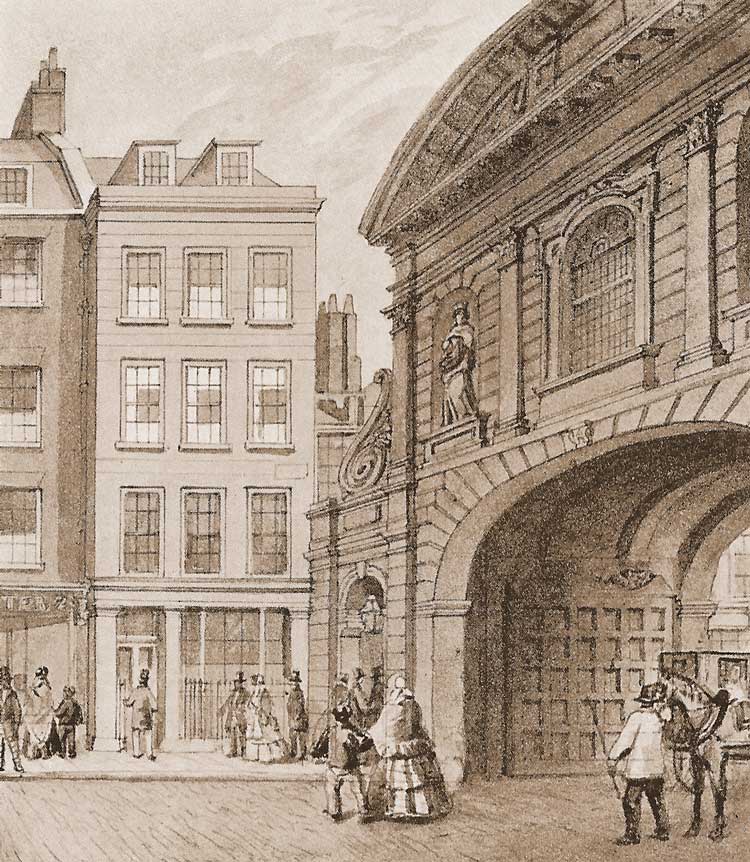
Child's Bank By Temple Bar.
The interior of the bank still has a decidedly antiquated feel, and it is worth stepping inside to view the glass case on the wall opposite the door, in which ten old guns are exhibited. The bank purchased these guns in June 1780 to defend the premises during the anti-Catholic Gordon Riots so vividly described by Dickens in Barnaby Rudge.
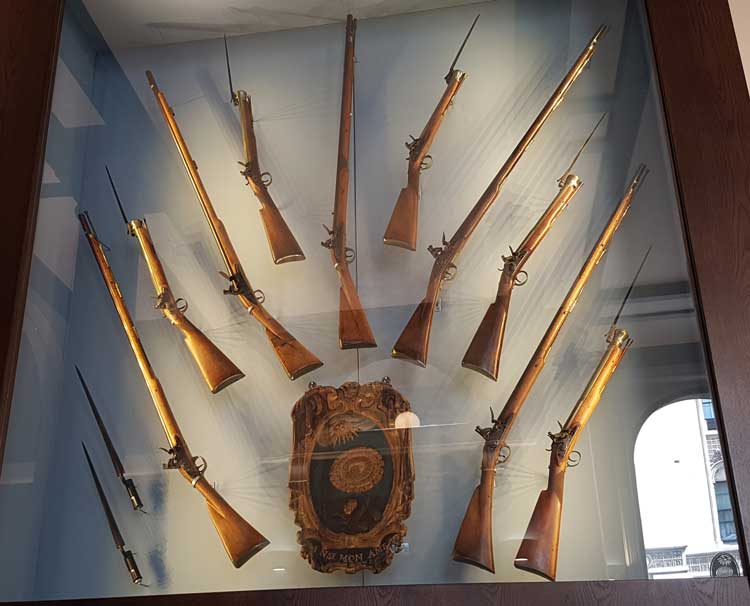
The Guns Displayed Inside Child's Bank.
Back track along Fleet Street and turn right through the gateway into Middle Temple Lane.
You have entered Middle temple, another of London's four Inns of Court.
Immediately, the blandness of late 20th-century architecture gives way to a tranquil oasis that has been left untouched by time and progress.
Elegant buildings of redbrick rise up on either side of the cobble-stoned byway, and Charles Lamb's sentiment that, "a man would give something to be born in such places" still holds true
Writing of this lovely enclave in Barnaby Rudge, Dickens had this to say:-
"There is yet a drowsiness in its courts and a dreamy dullness in its trees and gardens. Those who pace its lanes and squares may yet hear the echoes of their footsteps on the sounding stones and read upon its gates... "Who enters here leaves noise behind"."
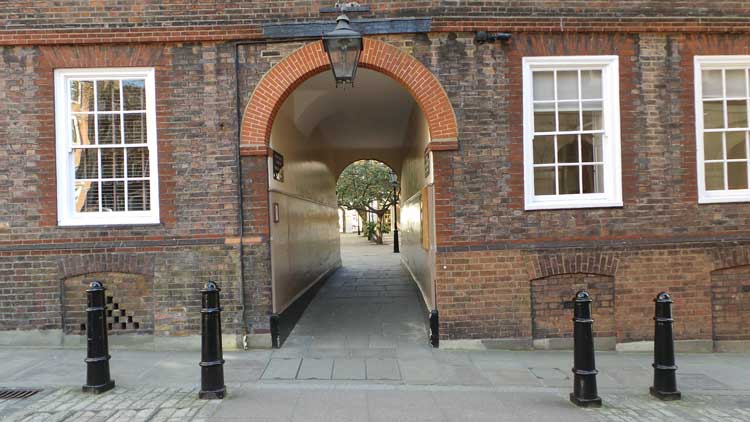
Looking Into The Temple's Pump Court.
Keep ahead, passing Brick Court on your right, then turn right beneath the soaring London plane trees. To your left is:-
The Middle Temple Lane gate from Fleet Street will be closed if you are doing the walk on a Saturday, Sunday, or public holiday. However, you can still get into the Temple by following this alternative route.
Keep walking along Fleet Street until you come to Bouverie Street.
Turn right along it, and go right along Tudor Street where you will find an open gate into the Temple.
Head diagonally right across the large square towards Paper Buildings. Pass to the left of the red post box, keep ahead past the gardens, pass though the arch, then turn right along Middle Temple Lane, and, on the left, you will come to Middle Temple Hall.
Built in the 1570's, this is a true time capsule of bygone London.
Each of the four Inns of Court possesses its own dining hall in which aspiring barristers must eat a certain number of dinners during each law term in order to be "Called to the Bar."
Despite heaping a goodly amount of scorn upon the legal profession, Dickens was not averse to participating in its traditions.
In 1839 he enrolled as a student barrister at Middle Temple, hoping that the law would provide a safety net should his writing career end. However, he failed to eat the required number of dinners and subsequently resigned his membership in 1855.
It was inside this hall that Shakespeare's Twelfth Night had its first performance, on the 2nd February, 1602.
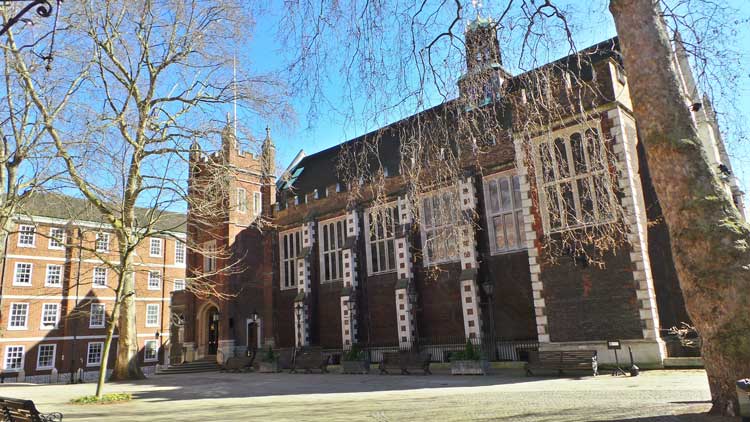
Middle Temple Hall.
Continue across the courtyard to the picturesque little fountain.
In Martin Chuzzlewit (1843–44), Dickens wove a romance around this court involving Ruth Pinch and John Westlock. The area has changed little since Dickens wrote of it:-
"Brilliantly the Temple fountain sparkled in the sun, and laughingly its liquid music played, and merrily the idle drops of water danced and danced, and peeping out in sport among the trees, plunged lightly down to hide themselves..."
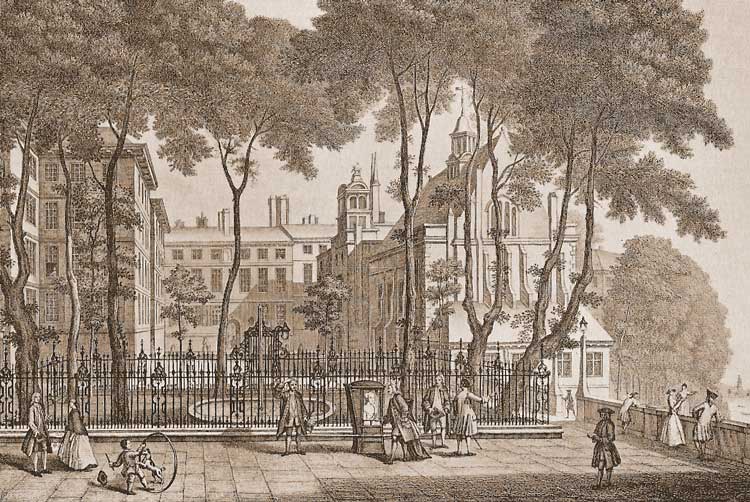
Fountain Court.
Cross over to the steps to the left of the little fountain and look down them at the red-brick building on the right opposite the garden. This is:-
Garden Court was the place where Pip was living in Great Expectations, when the convict Abel Magwitch turned up one storm-tossed night to reveal himself as the source of Pip's good fortune. Dickens has Pip explain how:-
"Alterations have been made to that part of the Temple since that time, and it has not now so lonely a character as it had then, nor is it so exposed to the river. We lived at the top of the last house, and the wind rushing up the river shook the house that night, like discharges of cannon, or breakings of a sea..."
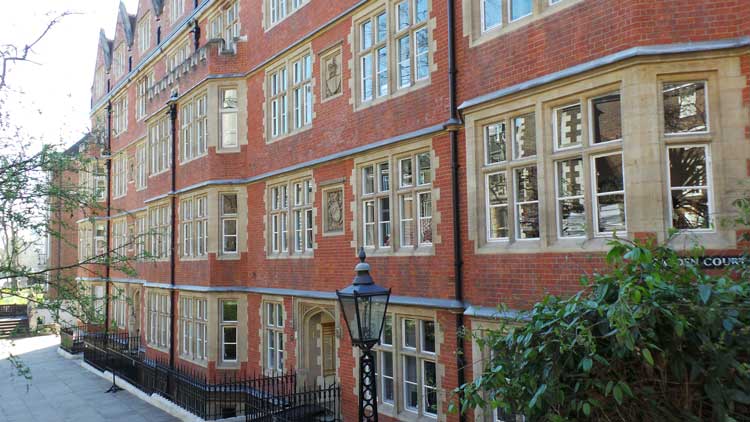
Garden Court.
Backtrack to Middle Temple Lane and continue over it to pass through the covered passageway into Pump Court, so called because the fire pumps were once located here.
As you pass through it, look up at the sun dial high on the left wall, noting its timely reminder "Shadows we are and like shadows depart."
continue through the cloisters where on the left you will find:-
The Temple gets its name from the Knights Templar, the monastic military order founded in 1118 with the avowed intent of protecting pilgrims on the road to Jerusalem.
This was their London citadel and in 1185 they built their Round Church, which was modelled on the Holy Sepulchre in Jerusalem.
The Templars were well-connected and soon became influential in the politics of the age. They quickly attracted grants of land and money as the younger sons of noble families flocked to enroll in their ranks, and by the 13th century they were one of the most powerful monastic orders in Christendom.
In England, the Master of the Temple was frequently called to sit in the King's Parliament and successive monarchs, King John included, frequently stayed at the Templars London base, and the Master of the order was by the King's side at the signing of Magna Carta.
By the early years of the 14th century the Templars were the most powerful monastic Orders in Europe and were answerable only to the Pope himself.
But their success attracted the jealousy and greed of many other Orders and eventually that of the nobility and monarchs of Europe as well.
In 1306, Philippe IV of France became determined to rid his territories of the Knight Templars.
At dawn on Friday, October 13th, 1307 the King made his move, and with the backing of the Pope, Clement V, all the Knights Templars in France were simultaneously arrested by Philippe's agents. Under torture, some Templars "admitted" to all manner of blasphemous and indecent acts. Many of their number were burnt at the stake and eventually in 1312 the order of the Knights Templar was officially dissolved throughout Europe.
There are many conspiracy theories concerning the real reason for dismantling of the order, and some of them go far beyond the simple and obvious motive that Philippe simply wanted to get his hands on their lands.
Several modern day fringe researchers have claimed that the order stored secret knowledge, linking them to the lost teachings and relics of Christ, including the Holy Grail; and the Temple Church itself now has the added "attraction" of having featured in both the book and the film of Dan Brown's The Da Vinci Code.
But, in London, their Round Church still stands as a proud testimony to these soldiers of Christ, and is well worth a visit, should time permit.
you can get details of admission charges and opening times on the Temple Church Website
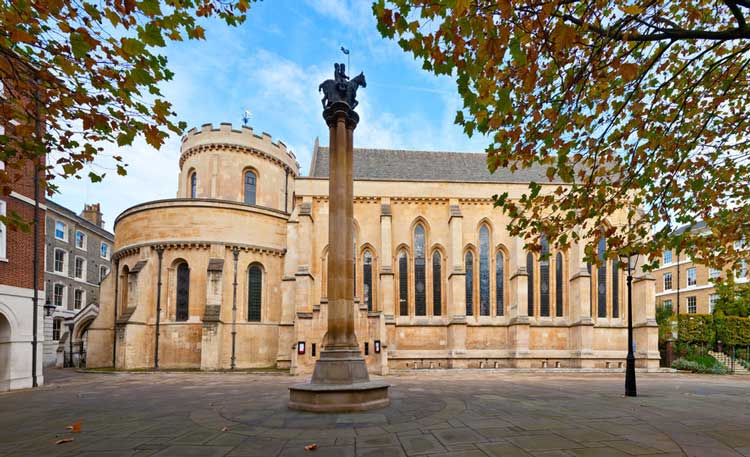
The Round Church Of The Templars.
In 1324 the Templars London estate was given to the Knights Hospitallers of St John, and some of the monastery buildings were rented to law students for accommodation.
The connection with the law flourished and it is lawyers who today worship in the church.
Despite its extensive renovation following bomb damage in the Second World War, the Temple Church is still a very special and atmospheric place.
The first thing that strikes you when you enter are the effigies of knights that lie peacefully recumbent on the floor within.
The hustle and bustle of the world outside seem centuries away as you stand gazing down upon these long ago members of the order; or as you admire the carved faces that adorn the interior wall of the church's round section, some of their expressions twisted into weird grimaces, whilst others are being gnawed at by bizarre and demonic creatures.
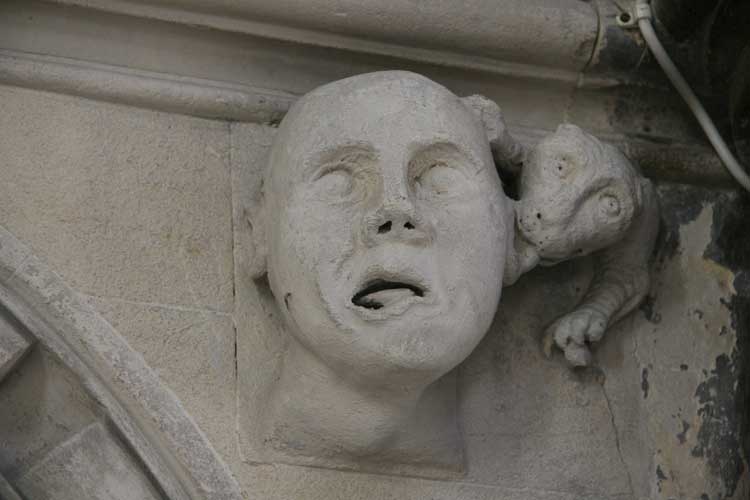
One Of The Faces Inside Temple Church.
Proceed clockwise round the church and, having passed Goldsmith's Buildings, stroll by the tombstones of the churchyard to the railing where you will find:-
Although Oliver Goldsmith (1730–74) was long dead by the time Dickens was born, he was one of Dickens's favourite boyhood authors and he remained so for the rest of his life.
Goldsmith's only novel The Vicar of Wakefield (1762) was a great influence on Dickens's early work, particularly Pickwick Papers.
Dickens gave his youngest brother, Augustus, the nickname Moses, in honour of Moses Primrose the Vicar's son in Goldsmith's book.
Forster, in his Life of Dickens, explained how, when this nickname was "facetiously pronounced through the nose' it became "Boses" and, on being shortened, became "Boz", which was the pseudonym that Dickens adopted in 1836, and under which much of his early work appeared.
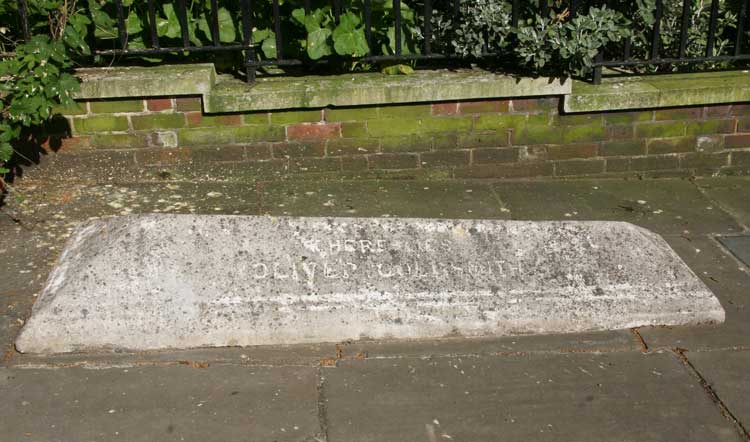
The Grave Of Oliver Goldsmith.
Backtrack past Goldsmith's Building and go right to exit the Inner Temple via the arched gateway. Above the gateway is a black and white timbered structure, which is:-
The building dates from 1610, and was named after the eldest son of King James 1st.
It was originally a tavern called the Prince's Arms.
In Dickens childhood the building was occupied by Mrs Salmon's Waxworks, which Charles certainly visited, and to which "perspiring Wax Works" he later sent David Copperfield.
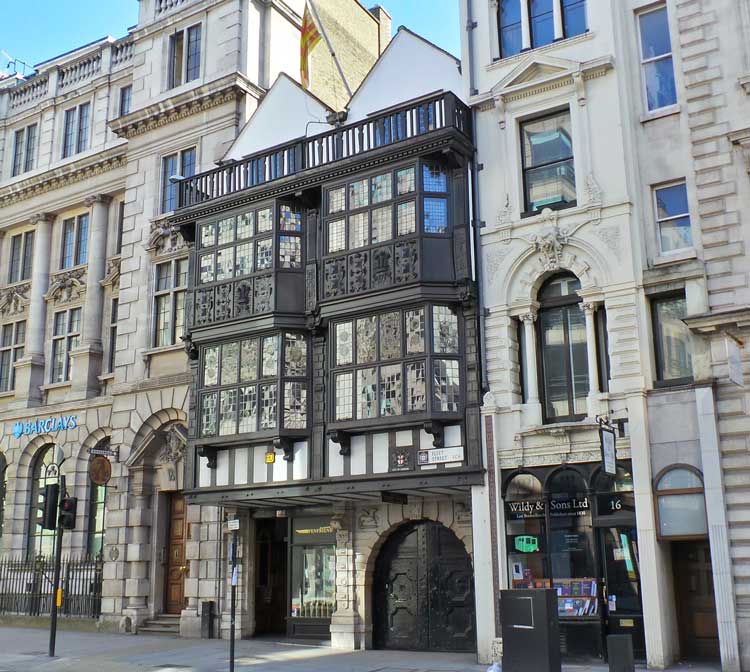
Prince Henry's Room.
Turn right along Fleet Street. Pause outside the premises of the bankers Messrs. Hoare and Co. to gaze across the road at:-
St Dunstan's Church, whose magnificent clock, dating from 1671, is said to have been the first clock in London with a double-sided face, and the first to have the minutes marked on the dial.
The chief glory of the clock, however, lies in the two ancient giants that wearily lift their clubs every fifteen minutes and make half-hearted attempts to strike the bells. Sadly their efforts are frequently drowned out by the noise of the Fleet Street traffic.
In David Copperfield, David and his aunt, Betsy Trotwood, make a special journey to witness the giants strike the bells, and time their visit "to catch them at it at twelve o'clock".
In 1830, the old church was demolished and the clock sold to the Marquis of Hertford who re-erected it at his house in Regent's Park.
Over 100 years would pass, before, in 1935, the clock was returned.
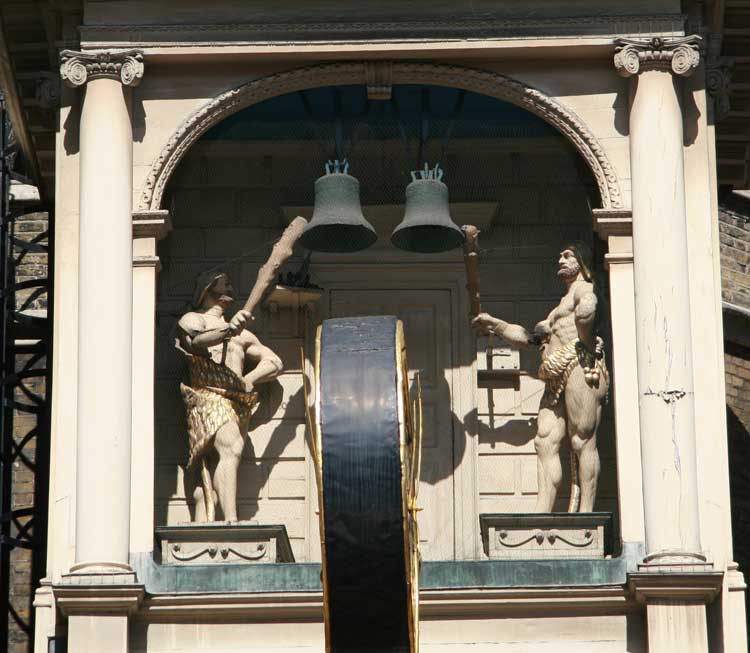
The Giants Of St Dunstan's.
Continue to the traffic lights. Cross over Fleet Street, veer left, and, a little way along on the right, dive into the grim, dark passageway named Hen and Chickens Court.
It admits you into a chilling, claustrophobic courtyard, where beneath your feet, hefty iron grilles cover precarious drops into mean looking cellars where all manner of horrors might be lurking.
You are standing at the rear of 185 Fleet Street where Sweeney Todd "the Demon Barber" had his premises.
His murderous, though fictional, escapades first appeared in print in 1847, and his story so captured the public imagination, that he became the most successful of all the Victorian melodramas.
His habit of murdering his clients and conveying them by way of an underground tunnel to nearby Bell Yard, where Mrs Lovett kept a meat pie shop, struck a chord with a reading public who were far more dependent on outside caterers than we are today!
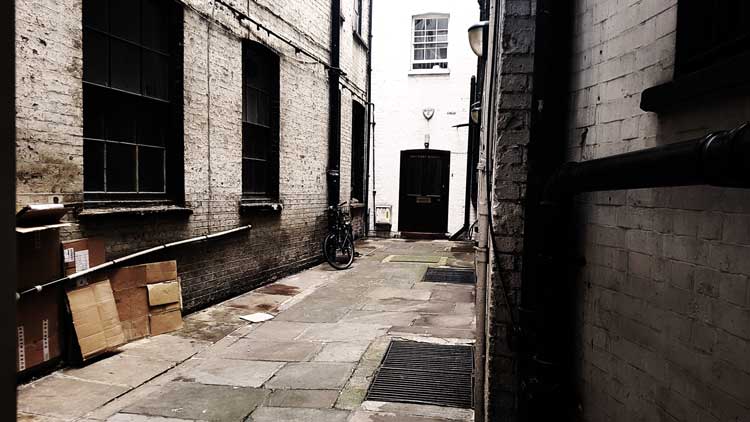
The Sinister Hen And Chickens Court.
Return to Fleet Street. Turn right, and, if they are open, enter the gates of St Dunstan's churchyard
The present building dates only from 1829 to 1833, but is an excellent early example of Gothic Revival architecture.
St Dunstan's In The West is the church of Dickens second Christmas book, The Chimes, and Dickens introduces us to it as follows:-
"But, high up in the steeple! There the foul blast roars and whistles! High up in the steeple, where it is free to come and go through many an airy arch and loophole, and to twist and twine itself about the giddy stair, and twirl the groaning weathercock, and make the very tower shake and shiver! High up in the steeple, where the belfry is, and iron rails are ragged with rust, and sheets of lead and copper, shrivelled by the changing weather, crackle and heave beneath the unaccustomed tread; and birds stuff shabby nests into corners of old oaken joists and beams; and dust grows old and grey; and speckled spiders, indolent and fat with long security, swing idly to and fro in the vibration of the bells, and never loose their hold upon their thread-spun castles in the air, or climb up sailor-like in quick alarm, or drop upon the ground and ply a score of nimble legs to save one life! High up in the steeple of an old church, far above the light and murmur of the town and far below the flying clouds that shadow it, is the wild and dreary place at night: and high up in the steeple of an old church, dwelt the Chimes I tell of.
They were old Chimes, trust me. Centuries ago, these Bells had been baptized by bishops: so many centuries ago, that the register of their baptism was lost long, long before the memory of man, and no one knew their names. They had had their Godfathers and Godmothers, these Bells (for my own part, by the way, I would rather incur the responsibility of being Godfather to a Bell than a Boy), and had their silver mugs no doubt, besides. But Time had mowed down their sponsors, and Henry the Eighth had melted down their mugs; and they now hung, nameless and mugless, in the church-tower.
Not speechless, though. Far from it. They had clear, loud, lusty, sounding voices, had these Bells; and far and wide they might be heard upon the wind. Much too sturdy Chimes were they, to be dependent on the pleasure of the wind, moreover; for, fighting gallantly against it when it took an adverse whim, they would pour their cheerful notes into a listening ear right royally; and bent on being heard on stormy nights, by some poor mother watching a sick child, or some lone wife whose husband was at sea, they had been sometimes known to beat a blustering Nor' Wester; aye, "all to fits," as Toby Veck said;—for though they chose to call him Trotty Veck, his name was Toby, and nobody could make it anything else either (except Tobias) without a special act of parliament; he having been as lawfully christened in his day as the Bells had been in theirs, though with not quite so much of solemnity or public rejoicing..."
It was in the tower of this church that Toby Veck (known as 'Trotty' on account of his gait) was subjected to a sequence of visions in The Chimes.
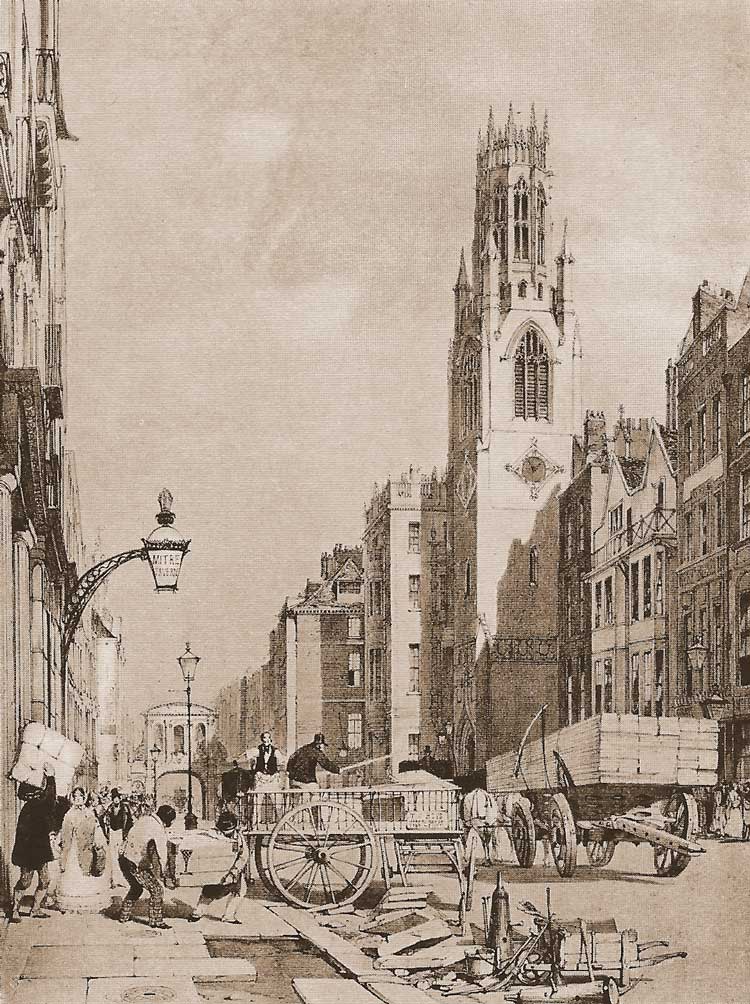
This Section Of Fleet Street As It Was In Dickens Day.
If it is possible, it is worth going into the porch, which is set back beyond the clock to view three of London's oldest statues, which depict King Lud and his two sons.
Lud was the legendary founder of London and these weatherworn statues once stood over Lud Gate (one of the medieval entrance points into London - Ludgate Hill, the road that runs down from St Paul's Cathedral commemorates it) until it was taken down in the 18th century.
These statues now lie abandoned and forgotten in this quiet recess away from Fleet Street.
Please note, the statues are currently boarded over.

The Statues Of King Lud And His Sons.
Continue along Fleet Street. Take the next right and pause outside the 17th-century gatehouse, which is all that survives of:-
Dickens, in Our Mutual Friend, has left an enduring, albeit uncomplimentary, portrait of Clifford's Inn. John Rokesmith, having followed Mr Boffin along Fleet Street, asks if he would:-
"...object to turn aside into this place – I think it is called Clifford's Inn – where we can hear one another better than in the roaring street? [Mr Boffin] glanced into the mouldy little plantation, or cat-preserve, of Clifford's Inn, as it was that day, in search of a suggestion. Sparrows were there, cats were there, dry rot and wet-rot were there, but it was not otherwise a suggestive spot."
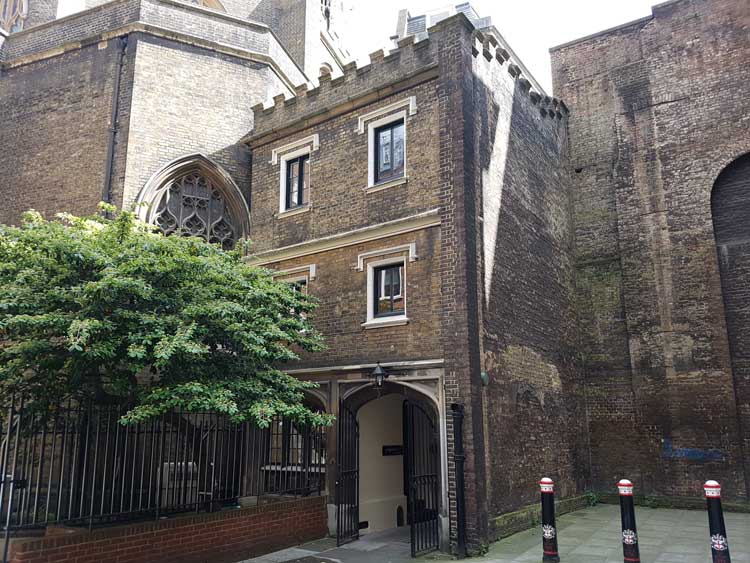
Inside The Gate Of Clifford's Inn.
Backtrack along Fleet Street and continue past St Dunstan's Church and keep ahead over Fetter Lane. Just past the bus stop bear left into:-
This narrow thoroughfare is perhaps one of the most important Dickensian sites on the walk, for here stood the office of The Old Monthly Magazine, a small-circulation periodical in whose December 1833 issue Dickens's first published story, A Dinner At Poplar Walk appeared.
Dickens later recalled how "stealthily one evening at twilight, with fear and trembling", he had dropped the story "into a dark letter-box in a dark office up a dark court in Fleet – street".
When he found that they had published it, he was so overcome with emotion that he "walked down to Westminster Hall, and turned into it for half an hour, because my eyes were so dimmed with joy and pride that they could not bear the street, and were not fit to be seen there".
Although he received no payment for his work, he wrote a further nine stories for the magazine and thus took his first tentative steps to becoming the "inimitable Boz".
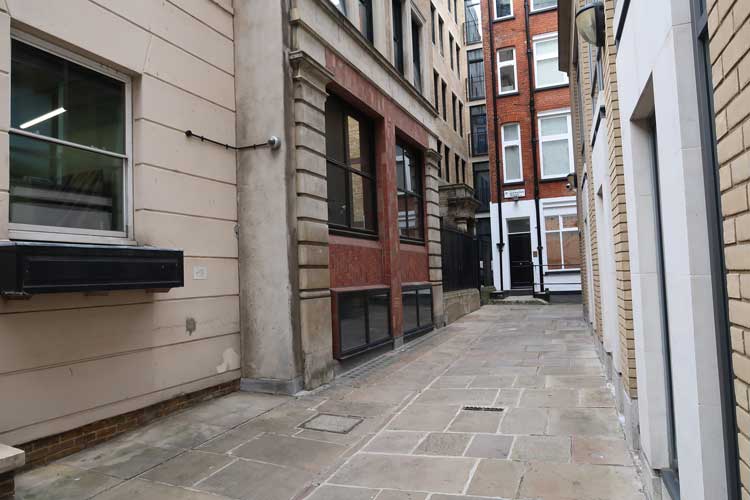
Johnson's Court As It Is Today.
Follow Johnson's Court as it meanders between tall buildings of differing ages and styles.
As it emerges into Gough Square, pause outside the house immediately on the left. This is:-
17 Gough Square, London, EC4A 3DE.
October to April: Monday - Saturday, 11am - 5pm.
May to September Monday - Saturday, 11am - 5.30pm.
There is an admission charge.
Samuel Johnson (1709-84), literary scholar and critic lived and worked here, compiling A Dictionary of the English Language, the first comprehensive English dictionary.
His monumental tome originated in 1746 when five London booksellers decided that a dictionary would be a guaranteed bestseller and approached Johnson to see if he would be interested in creating one. Since Johnson at the time was flat broke, their offer of 1500 guineas, half of which was to be paid up front, proved irresistible.
Eager to secure further funding Johnson sought a patron and approached Philip Dormer Stanhope, the fourth Earl of Chesterfield. Stanhope readily agreed to become the patron of the work, but showed a marked reluctance to contribute financially. Indeed the fact that all he handed over was a draft for a measly £10 rankled with Johnson.
When his Lordship then insisted on claiming a part of Johnson's triumph relations between the two men cooled considerably, with Johnson claiming that Chesterfield taught, "the morals of a whore and the manners of a dancing master."
The thick skinned Chesterfield laughed the attack off as a bit of good-natured banter, which it most certainly was not.
Still, Johnson at least had the seven hundred and fifty pounds advance, and so he rented these rooms in Gough Square, hired six serving men to work as amanuenses, and embarked upon a project that would take him six years to complete.
The finished work contained the definitions for an impressive, if not breathtaking, 43,500 words, amongst them such gems as "Oats a cereal eaten in England by horses and in Scotland by men!"
He was also able to avenge himself upon Lord Chesterfield - who was openly hinting that he had had a lot more to do with the work than he actually had - "Patron" wrote Johnson "a wretch who supports with indolence and is paid with flattery."
Chesterfield laughed that one off too.
Johnson's former house is now a museum dedicated to his memory and the original dictionary is on display inside. It is well worth a visit.
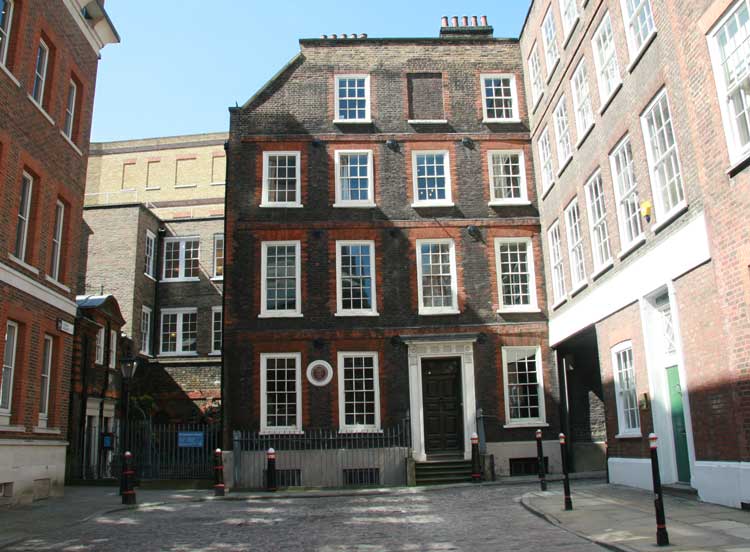
Dr Johnson's House, Gough Square.
With your back to Dr Johnson's House, go diagonally right across Gough Square, turning right at the statue of Dr Johnson's cat - Hodge.
On arrival at the flower bed, bear left and then right into Wine Office Court, where, a little way along on the left, the surging tide of modern urbanity is suddenly repelled by a time-worn step that delivers you into a true gem of bygone London:-
Rebuilt in 1667, this rambling tavern of creaking floors, cosy rooms and snug corners, possesses a timeless ambience that keeps the contemporary world firmly at bay.
Portraits of those who have worked and supped here over the centuries gaze fondly down from its dark wooden walls. Dr Johnson, Oliver Goldsmith, Mark Twain, Alfred Tennyson and Sir Arthur Conan Doyle – to name but a few – have all ducked beneath its low beamed ceilings to absorb its 17th-century atmosphere.
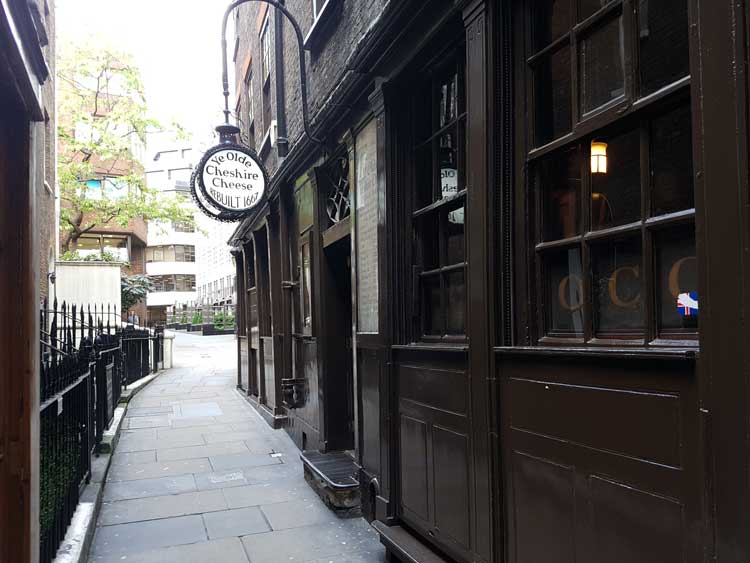
Ye Olde Cheshire Cheese.
Dickens, too, was a regular, and the table to the right of the ground floor restaurant's fireplace is said to have been his favoured place.
This is believed to have been the pub that Dickens had in mind when, following Charles Darnay's acquittal on charges of high treason in A Tale of Two Cities, Sydney Carton invites him to dine.
"...Carton, who smelt of port wine, and did not appear to be quite sober, laughed then, and turned to Darnay: "This is a strange chance that throws you and me together. This must be a strange night to you, standing alone here with your counterpart on these street stones?"
"I hardly seem yet," returned Charles Darnay, "to belong to this world again."
"I don't wonder at it; it's not so long since you were pretty far advanced on your way to another. You speak faintly."
"I begin to think I am faint."
"Then why the devil don't you dine? I dined, myself, while those numskulls were deliberating which world you should belong to - this, or some other. Let me show you the nearest tavern to dine well at."
Drawing his arm through his own, he took him down Ludgate-hill to Fleet-street, and so, up a covered way, into a tavern. Here, they were shown into a little room, where Charles Darnay was soon recruiting his strength with a good plain dinner and good wine: while Carton sat opposite to him at the same table, with his separate bottle of port before him, and his fully half-insolent manner upon him..."
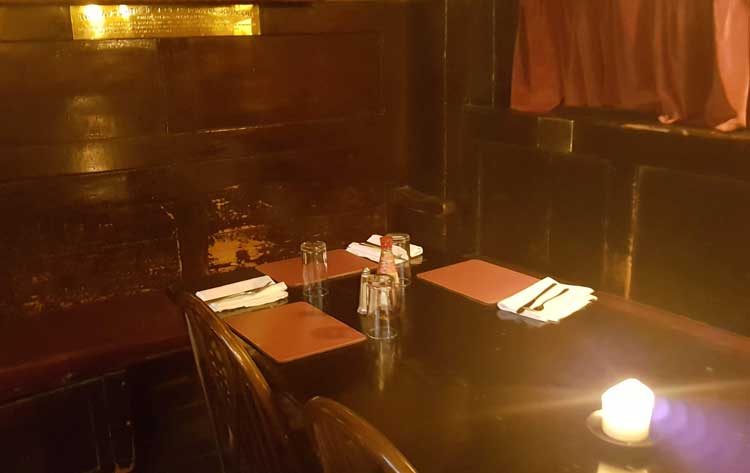
Dickens Is Said To Have Favoured This Corner When He Visited The Cheshire Cheese.
Before you leave Ye Olde Cheshire Cheese, it is worth looking above the till (cash register) in the bar to the right of the pub's entrance.
In a glass case, you can catch a view of "Polly" the Cheese's famous - or should that be infamous? - ex-parrot.
In the early 20th century, this parrot achieved international celebrity status because of its abilities of imitation. Visitors to London would make a point of dropping in at the Cheshire Cheese in order to make Polly's acquaintance.
It was also renowned for its colourful language - its extensive vocabulary having been acquired from soldiers who visited the pub whilst on leave during Word War One!
You can read a full account of the life and escapades of Polly the Parrot here.
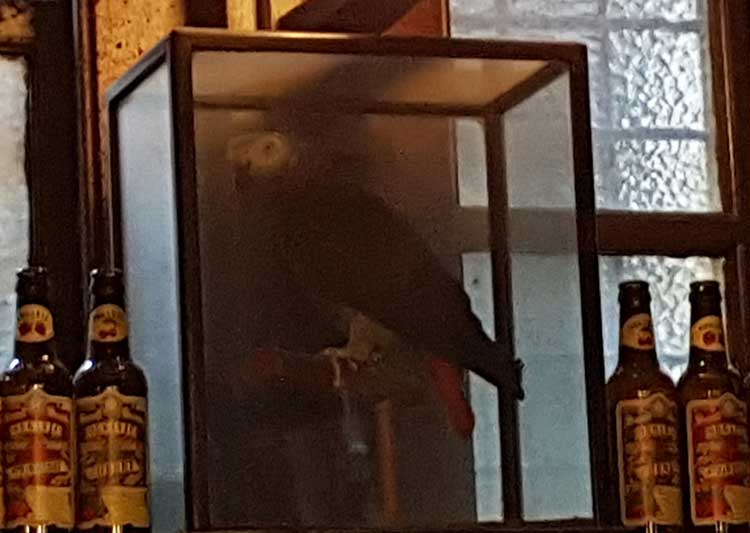
Polly The Infamous Parrot.
Leave Ye Olde Cheshire Cheese and turn left along Wine Office Court. At its end, go right along Fleet Street and cross it via the traffic lights pedestrian crossing.
Turn left on its other side, go right along Whitefriars Street and turn first left into the wonderfully named:-
"The scene was Mr. Cruncher's private lodging in Hanging-sword-alley, Whitefriars: the time, half-past seven of the clock on a windy March morning, Anno Domini seventeen hundred and eighty. (Mr. Cruncher himself always spoke of the year of our Lord as Anna Dominoes: apparently under the impression that the Christian era dated from the invention of a popular game, by a lady who had bestowed her name upon it.)
Mr. Cruncher's apartments were not in a savoury neighbourhood, and were but two in number, even if a closet with a single pane of glass in it might be counted as one. But they were very decently kept. Early as it was, on the windy March morning, the room in which he lay abed was already scrubbed throughout; and between the cups and saucers arranged for breakfast, and the lumbering deal table, a very clean white cloth was spread..."
As Hanging Sword Alley opens up into a wide court, turn left, pass through Hood Court, and turn right along Fleet Street. Just before the bus stop, pause outside the Sainsbury's Local shop, on the wall of which is a blue plaque marking the site of the offices of:-
Founded by and named for William Bradbury (1799[1]-1869) and Frederick Mullett Evans (1804[2]-1870) in 1830, Bradbury and Evans were printers for the first ten years of their existence, in which capacity they undertook work for Chapman and Hall, the publishers of Dickens early works.
In 1841, they purchased Punch magazine, and, in so doing, became publishers in their own right.
In 1844, Dickens broke with his original publishers, Chapman and Hall, and decamped to Bradbury and Evans who were then his publishers for the next fifteen years.
But, in 1857, following his separation from his wife, Catherine, Dickens asked that they publish a statement he had written in defence of his actions towards Catherine in Punch. Bradbury and Evans refused to do so, arguing that personal marital issues had no place in a satirical magazine.
Dickens was furious at what he saw as their betrayal of him, and he duly wrote to Frederick Evans to tell him that he could have no truck with someone who had been so "false" to him under the greatest wrong he had ever known.
From that point on he began winding down his association with Bradbury and Evans, breaking with them completely in 1859, after which he returned to Chapman and Hall.
he never spoke to Bradbury again, and vowed that he would, likewise, never have anything more to do with Evans.
Unfortunately, his eldest son, Charley, had become romantically involved with Evans's daughter, Bessie. When the two married a few years later, Dickens point blank refused to attend because the reception would be held at Evans's house.
Bradbury and Evans were also the publishers of William Makepeace Thackeray. From January 1847, they published his Vanity Fair in the periodical format that Dickens had popularised.
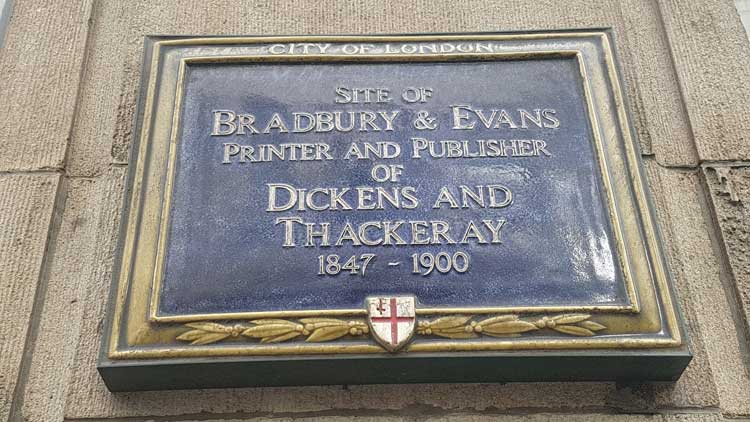
The Plaque For Bradbury And Evans.
Continue to the traffic lights at the end of Fleet Street, go left and cross Fleet Street, keep straight ahead on the other side, passing to the right of the M &S Simply Food Shop, and go next left into St Bride's Lane.
At it's top, go right along Shoe Lane and keep ahead to the point where it becomes St Andrew's Street.
Construction work is currently making this section of the walk a bit of a nightmare to negotiate, but soldier on - it will be worth it!
On arrival at St Andrew's Street, go right over the road and veer left into the continuation of Shoe Lane, which passes under the red bridge ahead.
To the right of this grimy, shabby thoroughfare once stood Field Lane, which is where Fagin's den was located in Oliver Twist.
It was swept away by the Holborn Valley improvement when Holborn Viaduct, the world's first flyover, which crosses over Shoe lane, was built in the late 1860's.
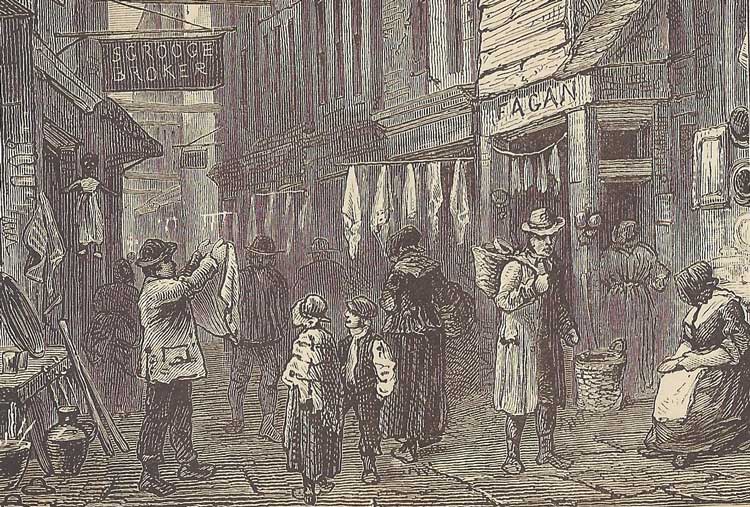
Field Lane As It Was When Dickens Wrote Oliver Twist.
At the end of Shoe lane, turn right along Charterhouse Street, and walk up to the traffic lights. Pause and look across at the church tower of St Andrew's Holborn:-
Bill Sikes and Oliver Twist pause to look up at the clock of the church, just as you are doing, as they set out to rob the house at Chertsey.
Taking a time-check on the clock, Sikes says to Oliver, "it's hard upon seven! You must step out."
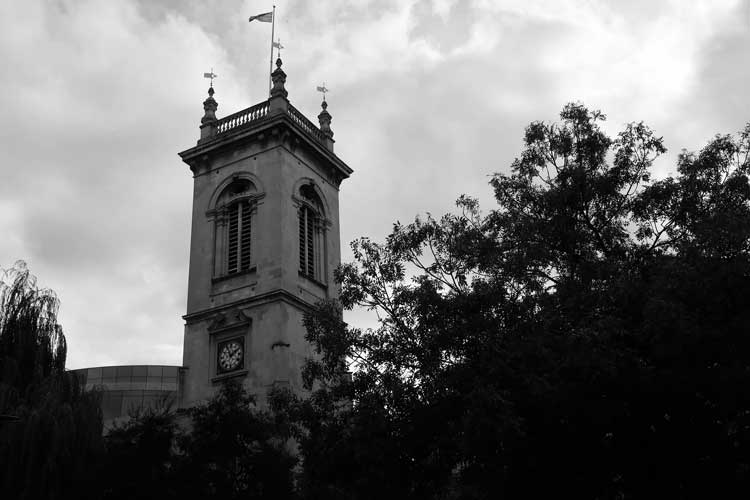
The Church Of St Andrew's, Holborn.
With your back to the church, cross over Charterhouse Street towards the Nat West Bank. Go left on the other side, cross over Hatton Garden, and veer left, to keep ahead along Holborn.
Keep walking until you arrive at the soaring red brick pile of the Prudential Building.
Turn right through its gates and cross to the tiny porch on the opposite side:-
The Prudential Building stands on the site of Furnival's Inn, where Dickens lived from 1834 to 1837.
During this time he began Pickwick Papers the work that set him on the road to literary fame.
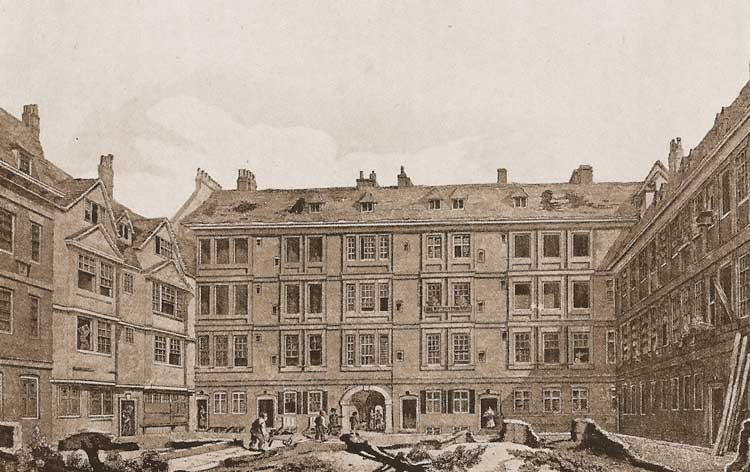
Furnivals's Inn As It Was When Dickens Lived There.
The book was actually the idea of Robert Seymour (1798–1836), one of the most popular comic illustrators of the 1830s. In the autumn of 1835, he approached the publishers Chapman and Hall with a series of sketches he had drawn depicting the mishaps of a group of comical cockneys known as the "Nimrod Club".
The publishers, who had asked several authors to write the captions without success, contacted the young journalist Charles Dickens, who was starting to make a name for himself with his Sketches.
From the outset Dickens was determined to keep overall control of the project, which was re-named Pickwick Papers, much to Seymour's consternation.
On 17th April, 1836, Dickens invited Seymour to "take a glass of grog’ at his lodgings in Furnival's Inn." The meeting, the only time the two men actually met, was tense, as Dickens demanded that Seymour change one of his illustrations. Dickens tried to be conciliatory, but Seymour, having suggested that a younger and more adaptable artist might "suit Mr Dickens better", cut the meeting short and left.
A few days later, having worked on the new designs as requested, he left a note of apology to "the best and dearest of wives", went into his garden shed, and shot himself through the heart.
Dickens moved quickly to recover from the blow of Seymour's death and set about finding a new illustrator. Among those who expressed an interest was William Makepeace Thackeray (1811–63), who would later become Dickens's chief rival amongst the Victorian literati. However, the job went to Hablot Browne (1815–82) who, having adopted the pseudonym "Phiz" to match Dickens's "Boz", remained Dickens's principal illustrator for the next 23 years.
Whilst living here Dickens married Catherine Hogarth and when Pickwick Papers proved a great success he was able to move to a large house that befitted his new-found wealth and status.
A somewhat raddled looking bust of Charles Dickens gazes dolefully out from a perspex case.
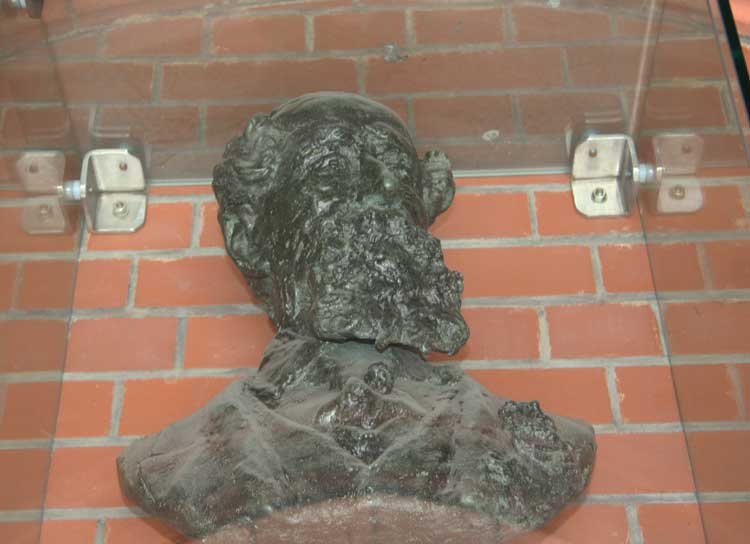
The Bust Of Charles Dickens.
Return to Holborn, turn right and keep ahead over Gray's Inn Road and keep ahead along High Holborn.
Continue, passing the Cittie of Yorke Pub, which, if open, is well worth stopping off at for a libation and to enjoy its truly Dickensian ambience.
A little way past the pub, turn right into Fulwood Place, and keep ahead to pass through the gate at its far end, and step into another of London's Inns of Court, Gray's Inn.
To the modern eye this is a delightful piece of bygone London, but Dickens was particularly unimpressed by it.
"Indeed", he wrote in The Uncommercial Traveller, "I look upon Gray's Inn...as one of the most depressing institutions in brick and mortar, known to the children of men."
Either there has been a great deal of change since he wrote those words, or else the drudgery of the 18 months he spent working as a clerk here clouded his judgment! But, more of that later.
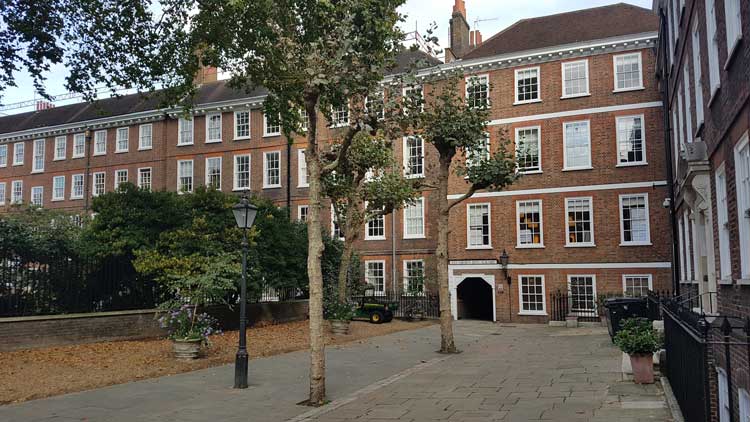
Gray's Inn.
Turn right once you have passed through the gate, keep ahead through the covered passage, and, on its other side, pause to admire:-
In Pickwick Papers, Mr Pickwick hurries to the square early one morning to consult with the lawyer Mr. Perker. Describing the scene in Gray's Inn Square, Dickens wrote:-
"It still wanted ten minutes to the hour when he had ascended the staircase on which Perker's chambers were. The clerks had not arrived yet, and he beguiled the time by looking out of the staircase window.
The healthy light of a fine October morning made even the dingy old houses brighten up a little; some of the dusty windows actually looking almost cheerful as the sun's rays gleamed upon them. Clerk after clerk hastened into the square by one or other of the entrances, and looking up at the Hall clock, accelerated or decreased his rate of walking according to the time at which his office hours nominally commenced; the half-past nine o'clock people suddenly becoming very brisk, and the ten o'clock gentlemen falling into a pace of most aristocratic slowness. The clock struck ten, and clerks poured in faster than ever, each one in a greater perspiration than his predecessor. The noise of unlocking and opening doors echoed and re-echoed on every side; heads appeared as if by magic in every window; the porters took up their stations for the day; the slipshod laundresses hurried off; the postman ran from house to house; and the whole legal hive was in a bustle."
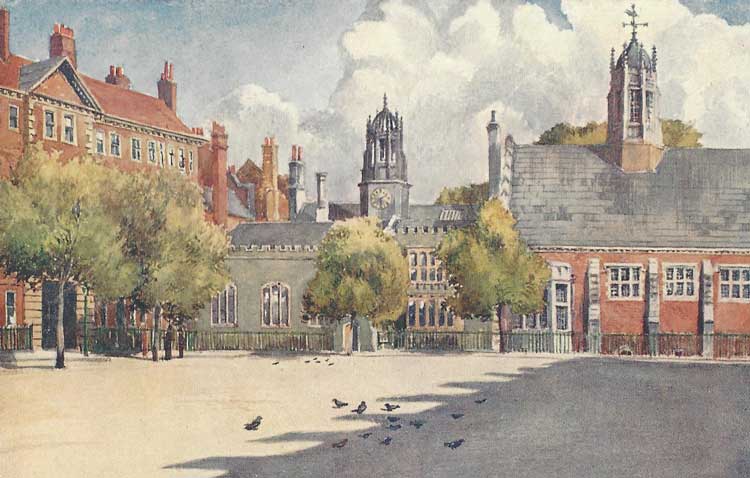
Gray's Inn Square As Dickens Would Have Known It.
Turn right, and keep ahead through the covered passageway and cross South Square, to pause outside Number 1 South Square, which was once:-
In 1827, Ellis and Blackmore, Solicitors, occupied "a poor old set of chambers of three rooms.." in this building.
It was here that Charles Dickens came to work in May 1827.
In those days it was No 5 Holborn Square, and it is the only building in the immediate vicinity to have survived the bombs of World War II.
So little has changed that you can just picture the "good looking and clever" young boy, his "healthy pink – almost glowing" complexion, expressive eyes and beautiful brown hair, worn long, as was then the fashion..." stepping across its threshold on his first day of employment.
Evidently the office comic, Dickens used to delight his fellow clerks with his talent for mimicry, whilst his knowledge of London, even at the age of 15, was both impressive and unrivalled.
One of his amusements was to drop cherry stones from the second floor offices onto the hats of passers-by below. Should anyone complain he would confront them "with so much gravity and with such an air of innocence, that they went away.."
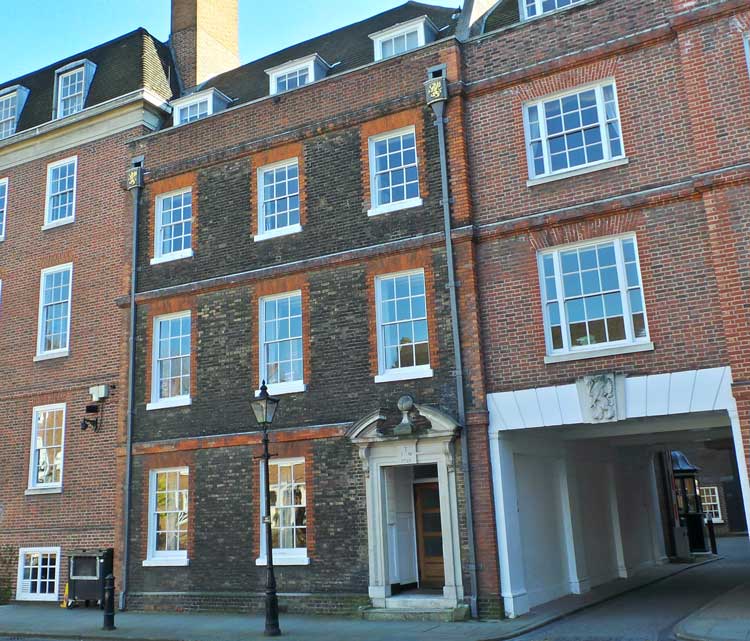
The Office Where Young Dickens Worked.
With your back to Number 1, backtrack across South Square and pass to the left of:-
As with the majority of the buildings in the vicinity, the dining hall of Gray's in underwent a great deal of restoration as a result of bomb damage in the Second World War. However, the restoration was tastefully done and, in consequence, you would hardly know that this wasn't the entire original building as it was when it was constructed in the first half of the 16th century.
The hall has many literary connections, chief amongst them being the fact that it was, reputedly, the venue for the first performance of Shakespeare's The Comedy of Errors in 1594.
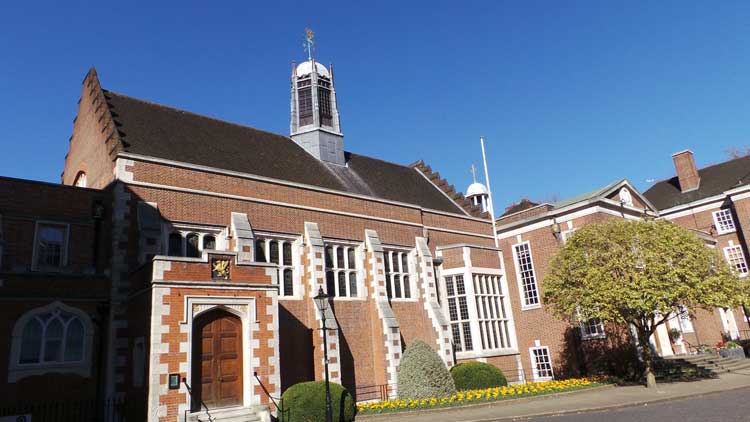
Go through the covered passage to the left of the hall, then turn first left through the covered passageway and pass by the beautiful Gardens of Gray's Inn on your right.
A little past the gardens, turn right and keep ahead to Raymond Buildings, making your way as far as number one.
Ellis and Blackmore moved to number one (rebuilt after World War 2 bomb damage) in December 1827 and Dickens remained with them until November 1828.
The desk at which he worked is preserved in the Dickens House Museum, to which you will shortly be making your way.
It was whilst working here that Dickens began to learn shorthand and, by 1829, he had become a shorthand writer in Doctor's Commons.
But his experiences at Ellis and Blackmore would resurface time and again in his fiction. Indeed, in the firm's petty cash book, now preserved in America, can be found such names as Weller, Bardell and Rudge, all of which he would use later in his novels.
Keep ahead through the gate, turn right along Theobald's Road and, a little way along, cross it (with extreme caution) using the central reservation.
Veer right on the other side, then go left into John Street.
Cross to its right side and keep ahead into Doughty Street.
Keep ahead until, on the right, you come to:-
48 Doughty St, London WC1N 2LX.
Opening Times: Tuesday to Sunday, 10am to 5pm, last admission 4pm.
There is an admission charge.
Dickens moved to this fine old Georgian house - which is now the Charles Dickens Museum - in March 1837, just as he was starting to find success as an author.
Whilst living here, he finished Pickwick Papers, wrote Oliver Twist and Nicholas Nickleby and began work on Barnaby Rudge.
By the time he moved out, in December 1839, he was famous throughout the world.
His daughters Mary and Kate were born here, and it was whilst living here that he cemented his life long friendship with John Forster.
It was the largest house he had lived in so far, and his domestic situation was, for a time, idyllic.
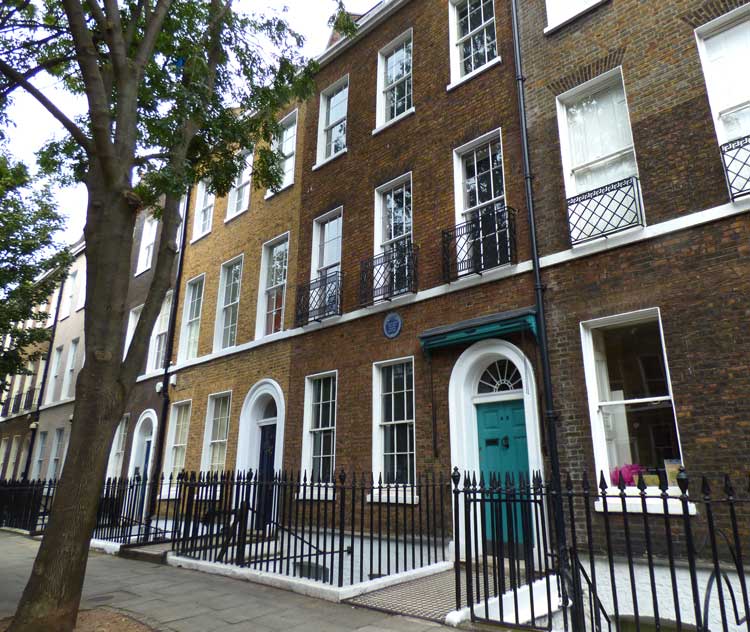
The Charles Dickens Museum, Doughty Street.
But, on 7th May, 1837 the idyll was shattered in a way that would affect him personally and professionally for the rest of his life.
His beloved sister-in-law, Mary Hogarth, collapsed in the early hours of the morning – doctors later diagnosed heart failure – and she died that afternoon in Dickens's arms.
The distraught Dickens removed a ring from her finger and wore it for the rest of his life. "Thank God she died in my arms," he said shortly after her death, "and the very last words she whispered were of me."
Instead Dickens and Catherine went to the wilder reaches of Hampstead to recover from the shock of their loss.
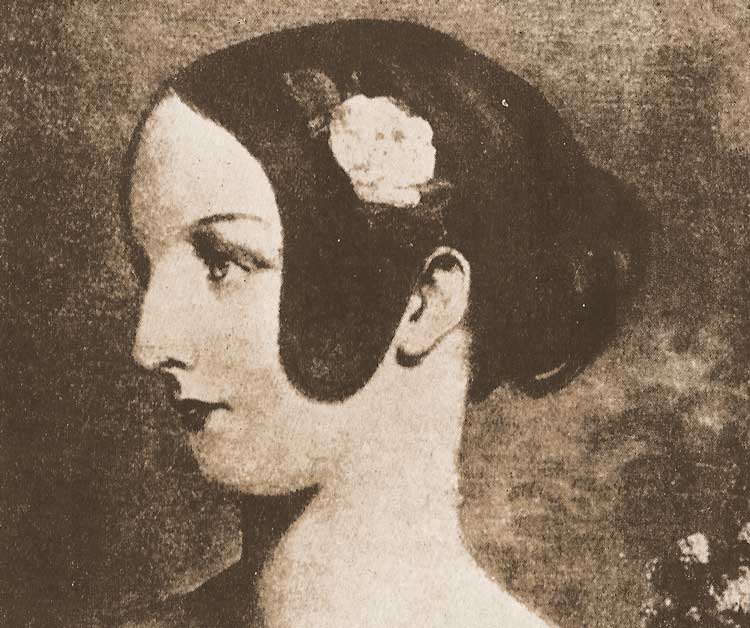
Mary Hogarth.
Professionally, the immediate effect of her death on him was that he was unable to write the next installments of Pickwick Papers and Oliver Twist.
But, in the years ahead, Mary Hogarth would be reincarnated time and again in his novels, becoming the all too perfect heroines such as Rose Maylie in Oliver Twist, Florence Dombey in Dombey and Son, Agnes Wickfield in David Copperfield, Lucy Manette in A Tale of Two Cities and, most famously, Little Nell, the unbelievably saccharine heroine of The Old Curiosity Shop.
As an article in The Dickensian Magazine put it in 1937, on the centenary of her death, "[Mary Hogarth] is part of the world's literature".
Her death may even have stunted his emotional growth, leaving him with an idealized image of womanhood, which must have affected his relationship with Catherine. As time and years of child bearing took their toll on Catherine Dickens, she was more and more unable to live up to his ideal.
For the rest of his life, Dickens would search for a new Mary Hogarth, and, it could be said, that the seeds of the later collapse of his marriage were sown in the room in Doughty Street where she died.
In 1922, The Dickens Fellowship rescued the house from demolition and, a few years later, opened it to the public.
It is now a treasure trove of relics and articles that depict his life and times and is the perfect place at which to end your tour of Dickens London.
Incidentally, if you want to have a bite to eat or a cup of tea or coffee before visiting the house, or beginning your journey home, you can enjoy the delightful little cafe at the rear of the house, with its lovely and tranquil little garden in which you can sit and relax after your morning or afternoon's exploration.